Electrostatics
Electric Potential
When two positively charged insulated conductors are connected by a metallic wire, charge flows from one conductor to the other. The direction of flow of charge does not depend on the amount of charge on them but depends on a specific electric condition of the two conductors.
This electric property of a charged body is called electric potential. So the electric potential of a body is the electric property that determines whether charge will flow from this body to any other body connected to ft or from any other body to itself.
1. Analogy between electric potential and hydrostatic level or height of water column: Two interconnected vessels A and B of different sizes contain water of different amounts held at different heights.
When the connection is established by opening the stop-cock D, water flows from the vessel with a higher level of water to the other, until the levels are equal.
Read and Learn More Class 12 Physics Notes
So the flow of water does not depend on the quantity of water but depends on the height of the water column or pressure of water. Similarly, the flow of charge or electricity between two bodies depends on the difference in their potential but not on the quantity of charge they have.
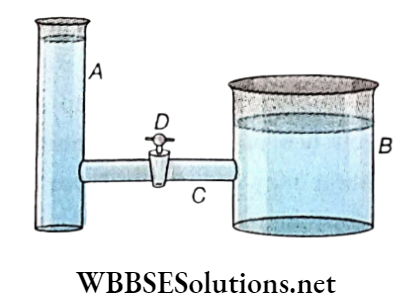
Water flows from higher to lower levels, i.e., from higher to lower pressure. Similarly, electric charge flows from one body at a higher potential to another at a lower potential.
So electric potential may be compared with the height of water as well as the pressure of water and the amount of charge with the quantity of water.
2. Analogy between electric potential and temperature: Heat flows from a hotter body to a colder one in contact till their temperatures are equalized. This occurs even if the heat content of the colder body is more than that of the hot one.
Thus flow of heat depends only on the temperature difference of the bodies in contact, but not on their heat contents. In this context, the electric potential may be compared with temperature and the amount of charge with heat.
It may be noted that while the flow of water or heat is indirect, the flow of charge depends on its nature. According to the sign convention, positive charge flows from higher to lower potential and negative charge from lower to higher potential. No charge however flows from one body to another if they are at the same potential
Potential at a Point in an Electric Field:
Consider an isolated charge in a region where no electric field is present. Now, due to the presence of the charge, an electric field develops in that region. When a second charge is brought into that region, an electric force acts on it.
To displace the second charge within this region, work has to be done, either by some external agent or by the field itself, depending on the nature of the charge.
Hence it can be concluded that a medium containing a charge acquires some property for which some work has to be done to displace another charge in that medium. This property is known as electric potential.
To define electric potential we need an infinitesimal test charge (q) that does not disturb the priorly existing charge (Q) which causes an electric field.
In this context, we shall name this test charge as a unit charge, i.e., q = 1. Also, we assume though there is no boundary of the electric field, the potential beyond the field i.e., at infinity is zero. The initial position of the test charge is assumed to be at infinity which is its reference point.
From this reference point if a unit positive charge is to be taken in an electric field one has to apply a minimum force (just equal but opposite to that electric field force) to take the test charge from infinity to a specific point in the electric field and hence work is to be done. As In such work done no net force is applied to the test charge it has no acceleration.
Definition: The potential at any point in an electric field is defined as the work done by external force in bringing a unit positive charge without acceleration from infinity to that point.
Suppose, the potential at any point in an electric field is V. By definition, work done to bring a unit positive charge from infinity to that point = V.
Therefore, work done to bring a charge q from infinity to that point, W = V.q
work done = potential x charge
This work done is stored up as electric potential energy of the system consisting of the charge and the external electric field. So, electric potential energy = potential x charge i.e., electric potential energy of a unit charge placed at a point in an electric field is the electric potential at that point.
In equation (1), since work done and charge are both scalar quantities, so, potential as well as potential energy are scalar quantities.
The potential of a positively charged body is said to be positive because work has to be done by some external agency to bring a unit positive charge from infinity to any point in the electric field.
This is to overcome the force of repulsion between the positively charged body and the unit positive charge (test charge). So energy is stored in the system consisting of the positively charged body and test charge. Therefore both W and V are positive.
On the other hand, the potential of a negatively charged body is said to be negative, because a unit positive charge moves itself closer to the charged body due to attraction, i.e., work is done by the attractive force. So both W and V are negative.
The potential difference between two points: The potential difference between two points in an electric field is defined as the amount of work done by an external force to bring a unit positive charge without acceleration from one point to the other.
Let VA and VB be the electric potentials at the points A and B, respectively in an electric field. If WAB is the work done in bringing the charge q from A to B, the physical difference between the two points is given by,
⇒ \(V_B-V_A=\frac{W_{A B}}{q}\)
If WAB is positive, VB>VA.
If WAB is negative, VB < VA.
If WAB is zero’ VB = VA.
The potential difference between two points Is independent of the path connecting the points:
The potential difference between two points in an electric field does not depend on the path followed from one point to another. The path may be straight or curved but the amount of work done, i.e., potential difference remains the same.
Proof: Supposed and B are two points in an electric field and an external agent performs an amount of work Wy to bring a unit positive charge from point A to point B along the path ACB. Now this unit positive charge is brought back to A from B along the path BDA. In this case, let us suppose that the work done by the electrical force = W2, where W2 is not W1.
Let W2 > W1.
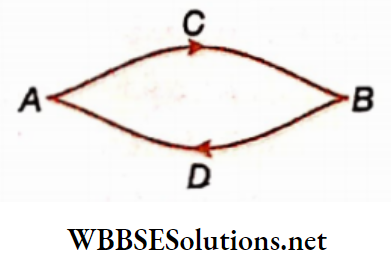
So the amount of work done in the whole process is (W2– W1); i.e., this net amount of energy will be surplus. If the unit positive charge is taken repeatedly along the closed path ACBDA, energy would evolve continuously.
However, according to the principle of conservation of energy, this is not possible. So (W2– W1) should be equal to zero, i.e., W2 = W1.
So in an electrostatic field, O’s total work done in moving a charge around a closed path is zero and the potential difference between two points is independent of the path along which a charge may be brought from one point to the other. So, like gravitational force, electrical force is also conservative.
Units of Potential:
1. GO In CGS system: The CGS unit of potential is esu of potential or statvolt (statV). The potential at a point in an electric field is said to be 1 esu if 1 erg of work is done in bringing 1 esu of positive charge from infinity to that point.
2. In SI: The SI unit of potential is volt (V). The potential at a point in an electric field is said to be 1 volt if 1 joule of work brings 1 coulomb of positive charge from infinity to that point.
\(1 \mathrm{~V}=\frac{1 \mathrm{~J}}{1 \mathrm{C}}=\frac{10^7 \mathrm{erg}}{3 \times 10^9 \text { esu of charge }}\)⇒ \(\frac{1}{300} \times \frac{1 \text { erg }}{1 \text { esu of charge }}\)
= \(\frac{1}{300}\) esu of potential
∴ 1 esu of potential = 300 volt
The unit of potential difference is the same as that of potential.
Dimension of Potential:
⇒ \([V]=\frac{[W]}{[q]}=\frac{\mathrm{ML}^2 \mathrm{~T}^{-2}}{I \mathrm{~T}}=\mathrm{ML}^2 \mathrm{~T}^{-3} \mathrm{I}^{-1}\)
The potential of the Earth:
The potential of a body is measured concerning the potential of the earth which is taken as the standard and conventionally assigned the value of zero. The earth is so large that its potential does not change appreciably due to small gain or loss of charge. It effectively maintains its constant potential.
A body is said to be at a positive potential if its potential is above that of the Earth and at a negative potential if its potential is below that of the Earth. This is analogous to the situation in that the sea level is taken as the standard zero level to measure the altitudes and depths of different places on the Earth.
Potential of a Charged Body:
A body is said to be at a positive potential if there is a flow of electrons from the earth to it when the body comes in contact with the earth. If electrons flow from the body to the earth when electrical contact is established between them, the body is said to be at a negative potential.
In both cases, the flow of electrons will continue until the potential of the body becomes zero, i.e., equal to the potential of the earth. Any earthed (or grounded) conductor is effectively at zero potential
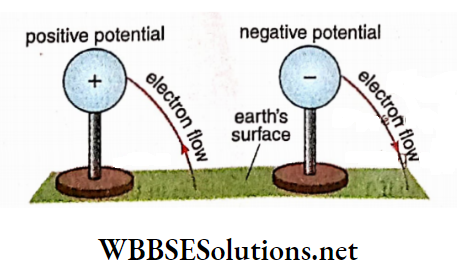
The measure of the potential of a charged body: The work done by an external force to bring a unit positive charge without acceleration very near to a charged body from infinity is the measure of the potential of that body
Potential at a Point in the Field of a Point Charge:
Consider a charge +q at a point A in vacuum or air. Let P be a point at a distance r from A, where the electric potential due to the charge at A is to be determined.
The intensity at P, in vacuum or air, due to the charge +q at
⇒ \(A=\frac{1}{4 \pi \epsilon_0} \frac{q}{r^2} ; \text { along } \overrightarrow{A P}\)
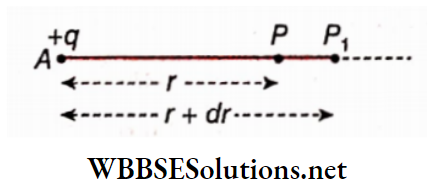
If PP1 = dr be a very small distance beyond P where the intensity effectively remains the same, then work done by the external force (equal but opposite of the electric force) in bringing a unit positive charge from Py to P is,
dW = external force acting on the unit positive charge x its displacement
⇒ \(\frac{1}{4 \pi \epsilon_0} \frac{q}{r^2} \cdot(-d r)\) [The negative sign is taken because intensity and displacement are oppositely directed]
Therefore, the work done in bringing the unit positive charge from infinity to P is given by,
⇒ \(W=\frac{1}{4 \pi \epsilon_0} \int_{\infty}^r \frac{-q}{r^2} d r=-\frac{q}{4 \pi \epsilon_0} \int_{\infty}^r \frac{d r}{r^2}\)
⇒ \(-\frac{q}{4 \pi \epsilon_0}\left[-\frac{1}{r}\right]_{\infty}^r=\frac{1}{4 \pi \epsilon_0} \frac{q}{r}\)
So, the potential at P due to the charge +q at A is,
⇒ \(V=\frac{1}{4 \pi \epsilon_0} \frac{q}{r}\)…..(1)
The potential of a point at a distance r from the charge q in a medium of permittivity e is,
⇒ \(V=\frac{1}{4 \pi \epsilon} \frac{q}{r}=\frac{1}{4 \pi \kappa \epsilon_0} \frac{q}{r}\)
In CGS system, for vacuum or in air, V = \(\frac{q}{r}\)
The potential difference between the two points:
Points are collinear with the charge: Suppose, B and A are two points at a distance r2 and r1 respectively from a point charge +q at O. The points 0, B, and A lie on the same straight line
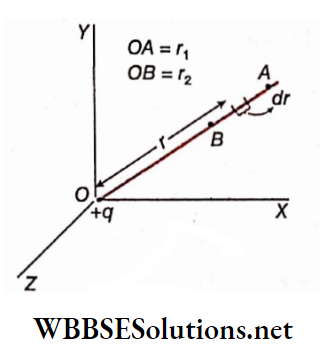
According to equation (1), the potential difference between B arid A is,
⇒ \(V_B-V_A=\frac{1}{4 \pi \epsilon_0} \int_{r_1}^{r_2} \frac{-q}{r^2} d \dot{r}\)
⇒ \(\frac{-q}{4 \pi \epsilon_0} \int_{r_1}^{r_2} \frac{d r}{r^2}=\frac{-q}{4 \pi \epsilon_0}\left[-\frac{1}{r}\right]_{r_1}^{r_2}\)
or, \(V_B-V_A=\frac{q}{4 \pi \epsilon_0}\left(\frac{1}{r_2}-\frac{1}{r_1}\right)\)….(2)
It may be noted that the potentials of the points equidistant from a point charge are equal.
For this reason, the potential difference between a point situated in a sphere of radius r2 and a point situated in a sphere of radius r1 may be obtained from equation (2).
2. For non-collinear points: Let the position vector of a point charge q be
⇒ \(\vec{r}\).
According to the \(\vec{r}_2 \text { and } \vec{r}_1\) be the position vectors of B and A respectively then equation (2) can be expressed as
VB – VA = \(\frac{q}{4 \pi \epsilon_0}\left(\frac{1}{\left|\vec{r}_2-\vec{r}\right|}-\frac{1}{\left|\vec{r}_1-\vec{r}\right|}\right)\)
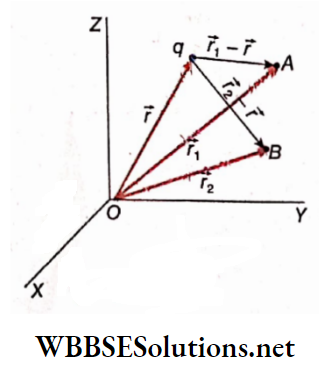
Potential due to a system of charges:
Consider the point charges q1, q2, q3 situated at distances r1, r2, r3,…. from a point P. Since the electric potential is a scalar quantity, the algebraic sum of the potentials at P due to individual charges is the potential at P. If the dielectric constant of a medium is K, then the potential at P due to multiple charges,
⇒ \(V=\frac{1}{4 \pi \kappa \epsilon_0}\left(\frac{q_1}{r_1}+\frac{q_2}{r_2}+\cdots+\frac{q_n}{r_n}\right)=\frac{1}{4 \pi \kappa \epsilon_0} \sum \frac{q}{r}\)
Potential due to an Electric Dipole:
1. Potential at a point on the axis of a dipole (end-on position):
Let AB be an electric dipole formed by the charges +q and -q separated by a small distance of 2l.
Obviously AB = 2l and dipole moment p = 2lq.
The dipole is placed in a vacuum or air. For this dipole, the potential at point P situated on the dipole axis at a distance r from the mid-point O of the dipole is to be determined. The distance of P from +q charge = (r – l) and that from -q charge = (r + l).
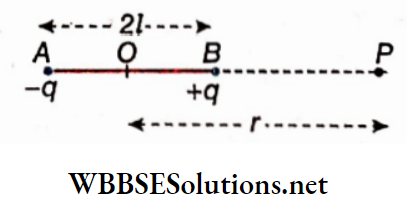
Therefore, the potential at P due to the charge +q at B of the dipole is
⇒ \(V_1=\frac{1}{4 \pi \epsilon_0} \frac{q}{(r-l)} \quad(\text { in SI })\)
Potential at P due to the charge -q at A of the dipole is
⇒ \(V_2=\frac{1}{4 \pi \epsilon_0} \frac{-q}{(r+l)} \quad \text { (in SI) }\)
Electric potential is a scalar quantity. So the resultant potential at P is
⇒ \(V=V_1+V_2=\frac{1}{4 \pi \epsilon_0}\left[\frac{q}{(r-l)}+\frac{-q}{(r+l)}\right]\)
⇒ \(\frac{q}{4 \pi \epsilon_0}\left[\frac{1}{(r-l)}-\frac{1}{(r+l)}\right]\)
⇒ \(\frac{q}{4 \pi \epsilon_0}\left[\frac{r+l-r+l}{\left(r^2-l^2\right)}\right]=\frac{q}{4 \pi \epsilon_0} \cdot \frac{2 l}{r^2-l^2}\)
⇒ \(\frac{1}{4 \pi \epsilon_0} \cdot \frac{p}{r^2-l^2}\) [∵ p = 2ip]….(1)
If r >> l, l2 can be neglected in comparison to r2.
Then the electric potential at P due to the electric dipole is
⇒ \(V=\frac{1}{4 \pi \epsilon_0} \frac{p}{r^2} \quad(\text { In SI) }\)….(2)
In the CGS system equations, (I) and (2) are respectively given by,
⇒ \(V=\frac{p}{r^2-l^2}\)…(3)
⇒ \(V=\frac{p}{r^2}\)…(4)
2. Potential at a point on the perpendicular bisector of a dipole (broadside-on position):
Let AB be an electric dipole formed by the charges +q and -q separated by a small distance 21. The dipole is situated in a vacuum or air. Obviously AB = 21 and dipole moment’ p = 2Iq.
For this dipole, the potential at P situated on the perpendicular bisector of the dipole at a distance r from the mid-point O of the dipole is to be determined.
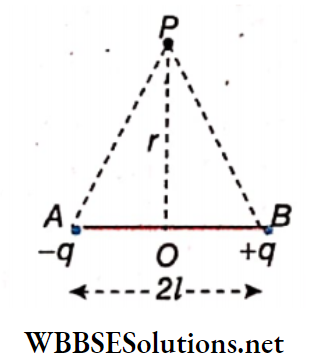
Potential at P due to the charge +q at B of the dipole is
⇒ \(V_1=\frac{1}{4 \pi \epsilon_0} \cdot \frac{q}{B P}\)
Potential at P due to the charge -q at A of the dipole is
⇒ \(V_2=\frac{1}{4 \pi \epsilon_0} \cdot \frac{-q}{A P}\)
Therefore, the net potential at P is
V = V1 + V2
⇒ \(\frac{1}{4 \pi \epsilon_0} \cdot \frac{q}{B P}+\frac{1}{4 \pi \epsilon_0} \cdot \frac{-q}{A P}\)
⇒ \(\frac{q}{4 \pi \epsilon_0}\left(\frac{1}{B P}-\frac{1}{A P}\right)=0\) [∵ BP = AP]…..(5)
So the electric potential is zero everywhere on the equatorial line of an electric dipole (but the electric intensity is not zero).
Hence this perpendicular bisector is an equipotential line. No work is done to move a charge along this line.
In the CGS system equation (5) remains the same, i.e., V = 0.
3. Potential at any point due to an electric dipole: Let AB be an electric dipole formed by the charges +q and -R separated by a small distance 21. AB = 2l and dipole moment p = 2lq. Let Pÿbe a point at a distance r from the mid-point O of the dipole and the line OP make an angle θ with the axis of the dipole i.e., the polar coordinates of P are (r, θ). Potential at P due to the dipole is to be calculated.
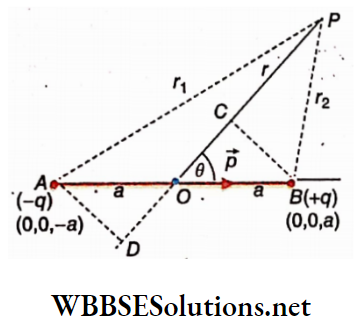
Now join PA and PB. Then draw a perpendicular from A which meets the extended OP at D. Also draw BC perpendicular to OP.
If r>>l, we can write BP ≈ CP = OP- OC = r – lcosθ and Ap ≈ DP = OP + OD = r + lcosθ
Now, the potential at P due to the charge +q at B of the dipole is
⇒ \(V_1=\frac{1}{4 \pi \epsilon_0} \cdot \frac{q}{B P}=\frac{1}{4 \pi \epsilon_0} \cdot \frac{q}{(r-l \cos \theta)}\)
Potential at P due to the charge -q at A of the dipole is-
⇒ \(V_i=\frac{1}{4 \pi \epsilon_0} \cdot \frac{-q}{A P}=-\frac{1}{4 \pi \epsilon_0} \cdot \frac{q}{(r+l \cos \theta)}\)
So, the net potential at P is
⇒ \(V^{\prime}=V_1+V_2=\frac{q}{4 \pi \epsilon_0}\left[\frac{1}{(r-l \cos \theta)}-\frac{1}{(r+l \cos \theta)}\right]\)
⇒ \(\frac{q}{4 \pi \epsilon_0}\left[\frac{r+l \cos \theta-r+l \cos \theta}{r^2-l^2 \cos ^2 \theta}\right]\)
⇒ \(\frac{q}{4 \pi \epsilon_0} \cdot \frac{2 l \cos \theta}{r^2-l^2 \cos ^2 \theta}\)
= \(\frac{1}{4 \pi \epsilon_0} \cdot \frac{p_{\cos \theta}}{r^2-l^2 \cos ^2 \theta}\)
⇒ \(\text { As } r \gg l \text {, we get } r^2-l^2 \cos ^2 \theta=r^2\)
∴ \(V=\frac{-1}{4 \pi \epsilon_0} \cdot \frac{p \cos \theta}{r^2}\)….(6)
Special Case:
CO P is on the axis of the dipole, then θ = 0 or, cosθ = 1
From equation (6) we get, \(V=\frac{1}{4 \pi \epsilon_0} \cdot \frac{p}{r^2}\)
This is equation (2).
2. If P is on the perpendicular bisector, then
θ = 90º
or, cos90º = 0
So from equation (6) we have, V = 0.
This is equation (5).
The vector form of equation (6) is
⇒ \(V=\frac{1}{4 \pi \epsilon_0}\).\(\frac{\vec{p} \cdot \hat{r}}{r^2}\)….(7)
where \(\hat{r}\) = unit vector along \(\hat{r}\)
In the CGS system equations (6) and (7) are respectively given by,
⇒ \(V=\frac{p \cos \theta}{r^2}\)….(8)
⇒ \(V=\frac{\vec{p} \cdot \hat{r}}{r^2}\)….(9)
Electrostatics
Electric Potential Relation Between Electric Field Intensity And Electric Potential
In uniform electric field: Suppose, A and B are two points on a field line in a uniform electric field of intensity E.
Let d be the distance between the two points and VA and VB be the electric potentials at A and B, respectively. The direction of electric intensity is from A to B, then VA > VB, and if a free positive charge is placed in this field the charge will move from A to B. Potential difference between A and
B = VA-VB.
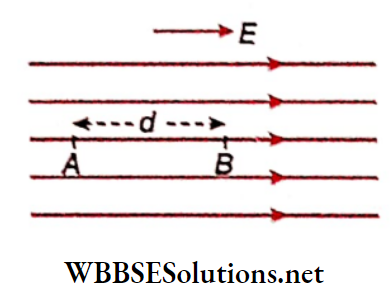
Work done to bring a unit positive charge from B to A
= -E.d [negative sign indicates that intensity and displacement are oppositely directed]
According to the definition of potential difference, this work done is equal to the potential difference between the two points.
∴ VA – VB = -E x d
or, \(E=-\frac{V_A-V_B}{d}\)….(1)
This is the relation between intensity and potential difference in a uniform electric field.
In A non-uniform electric field: Let us consider two points nA land £ very close to each other in a non-uniform electric field- and the distance between the two points = dx. Let the electric field intensity E be directed from A to B.
Since dx is very small, E is practically constant between A and B. As the direction of Intensity is from A to B, VA > VB.
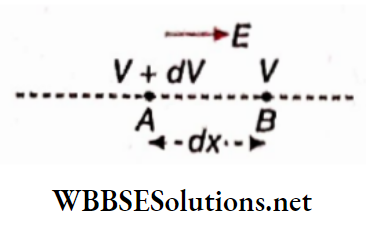
Let the potential at A be V+dV and that at B be V. The work done to bring a unit positive charge from B to A = -E.dx. [negative sign Indicates that intensity and displacement are oppositely directed]
According to the definition of potential difference, this work done is equal to the potential difference between the two points.
∴ (V+dV)-V = -Edx
or, \(E=-\frac{d V}{d x}\)…(2)
This is the relation between intensity and potential difference in a non-uniform electric field.
An alternative unit of electric field intensity: The relation E = – \(\frac{dV}{dx}\) suggests that, in the CGS system, a unit of electric field intensity is statV.cm-1 and in SI, it is V.m-1;
Electric potential gradient: In equation (2), \(\frac{dV}{dx}\) is known as a potential gradient. Potential gradient is the rate of change of electric potential concerning displacement. The negative sign indicates the value of potential gradually decreases as we proceed in the direction of the electric field.
Electric Field Intensity and Electric Potential due to a Uniformly Charged Sphere:
It is ten difficult to calculate electric field intensity and potential due to an irregularly shaped charged conductor. But for some regular shaped conductors, intensity and potential can be calculated easily. To calculate intensity and potential due to a uniformly charged sphere at an external point or on its surface, it can be assumed that the whole charge of the sphere is concentrated at its center.
Suppose a spherical conductor of radius r has q Unit of charge. For the calculation of electric field intensity and potential at P at a distance x from its center O, it is assumed that the charge q is concentrated at the center of the sphere.
The electric field intensity at \(p=\frac{1}{4 \pi \epsilon_0} \frac{q}{x^2}\)
[It is assumed that the sphere and the point P are In the air]
Electric potential at \(P=\frac{1}{4 \pi \epsilon_0} \frac{q}{x},(x>r)\)
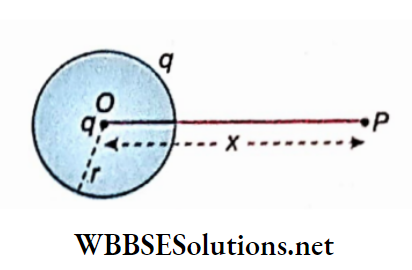
If point P is situated on the surface of the sphere, then x = r.
So electric field intensity on the surface of the sphere
⇒ \(\frac{1}{4 \pi \epsilon_0} \frac{q}{r^2} ; \text { and potential }=\frac{1}{4 \pi \epsilon_0} \frac{q}{r}\)
It can also be proved that the potential everywhere inside a charged sphere is equal, and the value of this potential is equal to that on its surface, i.e, \(\frac{1}{4 \pi \epsilon_0} \frac{q}{r}\)
Since the potential inside a sphere is a constant, it is obvious from the relation E = –\({dV}{dx}\), that the electric field intensity at every point inside a sphere is zero
Electrostatics
Electric Potential Relation Between Electric Field Intensity And Electric Potential Numerical Examples
Example 1. A region is specified by the potential function V = 2x2 + 3y3– 5z2. Calculate the electric field intensity at a point (2, 4, 5) in this region.
Solution:
We know, \(\vec{E}=E_x \hat{i}+E_y \hat{j}+E_z \hat{k}=-\frac{d V}{d x} \hat{i}-\frac{d V}{d y} \hat{j}-\frac{d V}{d z} \hat{k}\)
Now, V = 2x2 + 3y3– 5z2
∴ \(\frac{d V}{d x}=4 x ; \frac{d V}{d y}=9 y^2 ; \frac{d V}{d z}=-10 z\)
[here, x, y, and z are mutually independent variables]
At the point (2, 4, 5)
⇒ \(\frac{d V}{d x}=4 \times 2=8 ; \frac{d V}{d y}=9 \times(4)^2\)
= 144
⇒ \(\frac{d V}{d x}\)
= -10 x 5
= -50
∴ At the point (2, 4, 5), \(\vec{E}=-8 \hat{i}-144 \hat{j}+50 \hat{k}\)
∴ \(E=\sqrt{E_x^2+E_y^2+E_z^2}\)
⇒ \(=\sqrt{(8)^2+(144)^2+(50)^2}\)
= 152.64 units
Example 2. Two points A and B are situated at distances lm and 2 m from the source of an electrostatic field. The field at a distance x from the source is E = \(B=\frac{5}{x^2}\). What is the potential difference between A and B?
Solution:
We know that, E = –\(\frac{dV}{dx}\)
Here, \(B=\frac{5}{x^2}\)
∴ \(\frac{5}{x^2}=-\frac{d V}{d x} \quad \text { or, } d V=-\frac{5}{x^2} d x\)
∴ \(V_A-V_B=\int_2^1-\frac{5}{x^2} d x^{\prime}=-5\left[-\frac{1}{x}\right]_2^1\)
⇒ \(5\left(1-\frac{1}{2}\right)\)
= \(\frac{5}{2}\)
= 2.5 units
Example 3. In an electric field, the potential V(x) depending only on the x-coordinate, is given by V(x) = ax- bx3, where a and b are constants. Find out the points on the x-axis where the electric field intensity would vanish.
Solution:
⇒ \(E=-\frac{d V}{d x}=-\frac{d}{d x}\left(a x-b x^3\right)=-a+3 b x^2\)
E would vanish, i.e., E = 0, under this condition that,
⇒ \(-a+3 b x^2=0 \quad\)
or, \(x^2=\frac{a}{3 b} \quad\)
or, \(x= \pm \sqrt{\frac{a}{3 b}}\)
∴ The electric field intensity vanishes at the points
⇒ \(x=\sqrt{\frac{a}{3 b}} \text { and } x=-\sqrt{\frac{a}{3 b}} \text {, on the } x \text {-axis }\)
Electrostatics
Electric Potential Electrical Potential Energy
The electrical potential energy of a system of charges is equal to the total work done by an external agent to bring the charges, one by one, from infinite separation to the desired positions to form the system.
Let q1 and q2 be two charges placed at points A and B respectively and AB = r. To determine the potential energy of the system of the two charges q1 and q2, let us suppose that in the region only the charge q1 existed initially but q2 was absent.
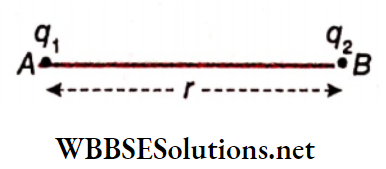
The potential at B due to the charge q1 is,
⇒ \(V=\frac{1}{4 \pi \epsilon_0} \frac{q_1}{r}\)
Now to bring the charge q2 from infinity to point B, work done,
⇒ \(W=V q_2\)
This work done gets stored in the system of charges q1 and q2 and is called the potential energy of the system (U)
So, \(U=V q_2=\frac{1}{4 \pi \epsilon_0} \frac{q_1 q_2}{r}\)…(1)
In the CGS system, ∈0 is to be replaced by \(\frac{1}{4 \pi}\) in equation (1).
The units of U in SI is joule (J) and in CGS is erg.
To determine the potential energy of a system of multiple charges, the above procedure has to be repeated step by step.
For a system of charges q1, q2, q3, q4……. we have to continue the calculations after equation (1) as follows :
1. Work done to bring the charge q3 from infinity to a point near the already formed system of q1 and q2;
2. Work done to bring the charge q3 from infinity to a point near the already formed system of q1, q2, and q3; and so on.
The algebraic sum of all the above values of work done would then be equal to the potential energy stored in the system of charges.
The procedure is often extremely complicated. However, the calculations turn out to be fairly easy for some systems with specific symmetries.
Calculation of electrostatic potential energy for a system ofiÿree point charges:
The potential; energy of a system of three charges q1, q2, and q3 is equal to the total work done to bring these charges one by one from infinity to the positions \(\vec{r}_1, \vec{r}_2 \text { and } \vec{r}_3\) respectively.
To bring the charge q1 at the position \(\vec{r}_1\), no work is done, as all other charges are still at infinity, i.e., there is no field.
So, W1 = 0
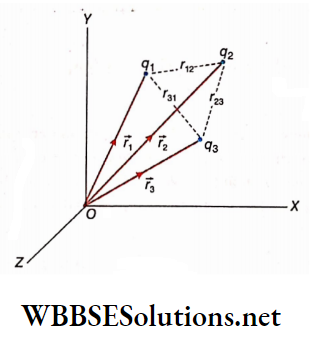
To bring the charge q2 from infinity to the position \(\vec{r}_2\) at a distance r12 from q1 , work is done
⇒ \(W_2=\left[\text { potential for } q_1\right] \times q_2=\frac{q_1}{4 \pi \epsilon_0 \kappa r_{12}} \times q_2=\frac{q_1 q_2}{4 \pi \epsilon_0 \kappa r_{12}}\)
Similarly, to bring the charge q3 from infinity to the position r3; work has to be done against the electrostatic forces of both q1 and q2,
W3 = [potential for q1 and q2] x q3
⇒ \(\frac{1}{4 \pi \epsilon_0 k}\left(\frac{q_1}{r_{13}}+\frac{q_2}{r_{23}}\right) \times q_3=\frac{1}{4 \pi \epsilon_0 \kappa}\left(\frac{q_1 q_3}{r_{13}}+\frac{q_2 q_3}{r_{23}}\right)\)
∴ The potential energy of a system of three charges,
U = W1 + W2 + W3
⇒ \(0+\frac{1}{4 \pi \epsilon_0 \kappa}\left(\frac{q_1 q_2}{r_{12}}\right)+\frac{1}{4 \pi \epsilon_0 \kappa}\left(\frac{q_1 q_3}{r_{13}}+\frac{q_2 q_3}{r_{23}}\right)\)
⇒ \(\frac{1}{4 \pi \epsilon_0 \times}\left[\frac{q_1 q_2}{r_{12}}+\frac{q_1 q_3}{r_{13}}+\frac{q_2 q_3}{r_{23}}\right]\)
Work Done in Deflecting a Dipole in a Uniform Electric Field and Potential Energy of the Dipole:
Consider an electric dipole placed at an angle θ with a uniform electric field of strength E. The dipole moment dipole is p. We know that the torque acting on is,
\(\tau_{\text {ext }}=p E \sin \theta\)This torque acting on the dipole brings it along the direction of the electric field. Obviously when θ = 0°, the dipole is in equilibrium position. To deflect it from its equilibrium position work has to be done on the dipole. This work is stored up as potential energy in the dipole at its deflected position.
Suppose, the dipole is in an equilibrium position. An external torque acts on it and deflects it through an angle of θ, In this position the magnitude of the torque applied by the external agent is,
⇒ \(\tau_{\text {ext }}=p E \sin \theta\)
Work done by the external agent to deflect it from angle θ to θ + dθ is,
⇒ \(d W=\tau_{\text {ext }} d \theta\)
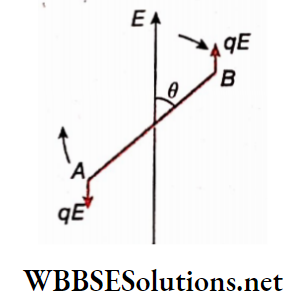
So, work done to deflect the dipole from its equilibrium position to an angle of θ is
⇒ \(W=\int_0^\theta \tau \tau_{\mathrm{ext}} d \theta\)
⇒ \(\int_0^\theta p E \sin \theta d \theta=p E(1-\cos \theta)\)
Therefore, in this position potential energy of the electric dipole
is given by,
U = pE(1-cosθ)
From equation (1) we can say that to deflect the dipole
1. From the equilibrium position through an angle of 90°, work done, W = pE
2. From the equilibrium position through an angle of 180°, work done, W = 2pE
3. From angle θ1 to angle θ2, work done, W = pE(cosθ1 – cosθ2)
Again, let the dipole at first be at right angles to the electric field.
Then to bring the dipole from that position to an angle of θ, the change in potential energy is given by,
⇒ \(U(\theta)-U\left(\frac{\pi}{2}\right)=\int_{\pi / 2}^\theta p E \sin \theta d \theta\)
⇒ \(p E[-\cos \theta]_{\pi / 2}^\theta=-p E \cos \theta=-\vec{p} \cdot \vec{E}\)
The work done on a dipole is equal to the difference in potential energies between its two orientations.
As the initial value of potential energy is not physically significant, it can be taken as zero for any standard orientation of this dipole.
If we take the potential energy of the dipole to be zero when It remains at right angles to the electric field, then \(U\left(\ \ \frac {\pi}{2}\right)=0\)
Therefore in that case,
⇒ \(U(\theta)=-\vec{p} \cdot \vec{E}\)…(3)
Kinetic Energy of a Charged Body in an Electric Field:
We know that, when a body falls freely from a height under the action of gravity, it loses its potential energy but gains an equal amount of kinetic energy.
Similarly, when a charged body moves freely in an electric field, it loses a certain amount of potential energy and gains an equal amount of kinetic energy. Suppose a particle of charge q is moving from one point to another in an electric field.
If the potential difference between the two points is V, the particle loses potential energy of amount q V. So the increase of its kinetic energy will also be,
Ek = qV….(1)
If m is the mass of the particle and v1, v2 is its velocities at the first and the second points, respectively, then
⇒ \(E_k=\frac{1}{2} m\left(v_2^2-v_1^2\right)\)…(2)
∴ \(\frac{1}{2} m\left(v_2^2-v_1^2\right)=q V\)….(3)
If the particle starts from rest and acquires a velocity v at the second point then,
⇒ \(\frac{1}{2} m v^2=q V \quad\)
or, \(v=\sqrt{\frac{2 q V}{m}}\)…..(4)
With the help of this equation, velocities of charged particles like electrons, protons, etc., are determined in different atomic and nuclear experiments.
Electronvolt: It is a special unit of energy. The energies of particles like electrons, protons, etc., in atomic and nuclear physics are measured in this unit.
Definition: The amount of kinetic energy acquired by an acquired by electron, when it accelerates through a potential difference of 1 volt, is called an electronvolt (eV).
1 electronvolt (leV)
= charge of an electron x IV
= 4.8 x 10-10 esu of charge x \(\frac{1}{100}\) esu 0f potential
= 1.6 x 10-12 erg
= 1.6 X 10-19J [∵ 1 erg = 10-7 J ]
Bigger units like electron volt (keV), mega electron volt (MeV), etc. are also used.
IkeV = 103 eV = 1.6 X 10-9 erg = 1.6 X 10-16 J
IMeV = 106 eV = 1.6 X 10-6 erg = 1.6 x 10-13 J
Electrostatics
Electric Potential Electrical Potential Energy Numerical Examples
Example 1. Two point charges of +49 esu and +81 esu are placed at a separation of 100 cm In the air. Determine the position of the neutral point in the electric fields of the two charges. What Is the electric potential at the neutral point?
Solution:
The neutral point must be in between the two charges because both charges are positive. Let +49 esu and +81 esu of charges be placed respectively at A and B.
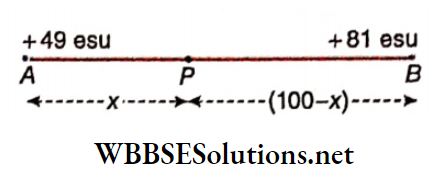
Let the neutral point P be at a distance x cm from point A. So the distance of P from the point B is (100- x) cm.
According to the question,
⇒ \(\frac{49}{x^2}=\frac{81}{(100-x)^2} \quad \text { or, } \frac{7}{x}=\frac{9}{100-x}\)
or, x = 43.75 cm.
So the neutral point is on line AB at a distance of 43.75 cm from the charge +49 esu.
If V is the potential at the neutral point, then
⇒ \(V=\frac{49}{43.75}+\frac{81}{56.25}\)
= 1.12 + 1.44
= 2.56 esu of potential
Example 2. An electron–Is subjected to a potential difference- of 180 V. The Mass and charge of an electron are 9 x 10-31 kg and 1.6 X 10-19 C, respectively. Find the velocity Definition: The amount of kinetic energy acquired by an acquired by electron.
Solution:
Here, mass of the electron, m = 9 x 10-31 kg
Charge of the electron, e = 1.6 x 10-19 C
Potential difference, V = 180 V
∴ Velocity acquired by the electron, v is given by
⇒ \(\frac{1}{2} m v^2=\mathrm{eV}\)
or, \(v=\sqrt{\frac{2 e V}{m}}=\sqrt{\frac{2 \times 1.6 \times 10^{-19} \times 180}{9 \times 10^{-31}}}\)
= 8 x 106 m.s-1
Example 3. At each of the four vertices of a square of side 10 cm, four positive charges each of 20 esu are placed. Find the potential at the point of Intersection of the two diagonals.
Solution:
Amount of charge at each comer, q – 20 esu charge
Length of each side of the square =10 cm
So, length of the diagonal = \(\sqrt{10^2+10^2}=10 \sqrt{2} \mathrm{~cm}\)
The distance of a vertex from the point of intersection of tire diagonals is,
∴ \(x=\frac{1}{2} \times \text { length of the diagonal }=\frac{1}{2} \times 10 \sqrt{2}=5 \sqrt{2} \mathrm{~cm}\)
∴ A Potential at the point of intersection of the two diagonals
⇒ \(\frac{20}{5 \sqrt{2}}+\frac{20}{5 \sqrt{2}}+\frac{20}{5 \sqrt{2}}+\frac{20}{5 \sqrt{2}}\)
⇒ \(\frac{80}{5 \sqrt{2}}=8 \sqrt{2}\)
= 11.31 statV
Example 4. The distance between two points A and B in vacuum is 2d. At each of these two points, a +Q charge is placed. P is the midpoint of AB. Find the intensity and potential at P due to the electric field. How will the value of these quantities change if the charge at B is replaced by a charge -Q?
Solution:
AB = 2d; midpoint of AB is P, i.e., AP = BP = d
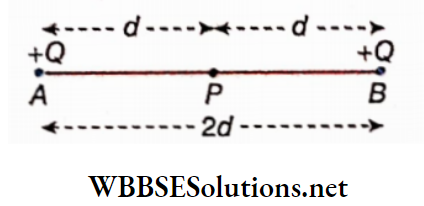
Intensity at P due to the charge + Q at A
⇒ \(\frac{Q}{d^2} \text {; along } \overrightarrow{P B}\)…(1)
Intensity at P due to the charge +Q at B
⇒ \(\frac{Q}{d^2} \text {; along } \overrightarrow{P A}\)….(2)
So, intensities at P due to the charges at A and B are equal and opposite.
Therefore, the resultant intensity at P is zero.
Potential at P due to the charge at A = \(\frac{Q}{d}\)…(3)
Potential at P due to the charge at B = \(\frac{Q}{d}\)….(4)
∴ Total potential at \(P=\frac{Q}{d}+\frac{Q}{d}=\frac{2 Q}{d}\)
Now if-Q charge is placed at point B, intensity in equation (2) will be
⇒ \(\frac{Q}{d^2} \text { along } \overrightarrow{P B}\)
∴ Resultant intensity at \(P=\frac{Q}{d^2}+\frac{Q}{d^2}=\frac{2 Q}{d^2} ; \text { along } \overrightarrow{P B}\)
Again the value of potential in equation (4) will be –\(\frac{Q}{d}\).
∴ Total potential at \(P=\frac{Q}{d}-\frac{Q}{d}=0\)
Example 5. At each of the four vertices of a square of side 10 cm, four positive charges each of 20 esu are placed. Find the potential at the point of Intersection of the two diagonals.
Solution:
Length of each side of the square
⇒ \(\sqrt{10^2+10^2}=10 \sqrt{2} \mathrm{~cm}\)
The point of intersection of the two diagonals is die point O
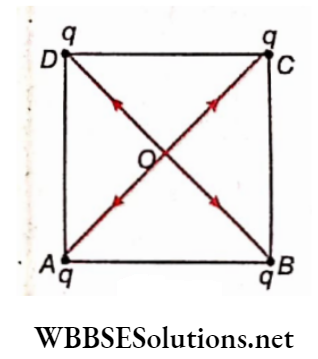
∴ AO = BO = CO = DO cm = \(\frac{10 \sqrt{2}}{2}=5 \sqrt{2} \mathrm{~cm}\)
Intensity acts along \(\vec{OC}\) due to the charge at A and it acts along \(\vec{OC}\) due to the charge at C.
So resultant intensity at O due to the charges at A and C is given by
⇒ \(E_1=\frac{100}{(5 \sqrt{2})^2}-\frac{20}{(5 \sqrt{2})^2}\)
⇒ \(\left(2-\frac{2}{5}\right)=\frac{8}{5} \text { dyn } \cdot \text { statC }^{-1} ; \text { along } \overrightarrow{O C}\)
Similarly, the intensity at O due to the charges at B and D acts along
⇒ \(\vec{OB}\).
So, the resultant intensity at O due to the charges at B and D is given by,
⇒ \(E_2=\frac{30}{(5 \sqrt{2})^2}+\frac{50}{(5 \sqrt{2})^2}\)
⇒ \(\left(\frac{3}{5}+1\right)=\frac{8}{5} \mathrm{dyn} \cdot \text {statC }^{-1} \text {, along } \overrightarrow{O B}\)
Here E1 and E2 act perpendicular to each other and Ey = E2
Resultant intensity at O,
⇒ \(E=\sqrt{E_1^2+E_2^2}=\sqrt{\left(\frac{8}{5}\right)^2+\left(\frac{8}{5}\right)^2=\frac{8}{5} \sqrt{2}}\)
= 2.263 dyn.statC-1
The direction of E is along the bisector \(\vec{OP}\) of the angle COB i.e., parallel to the side AB or DC.
Again, potential at O = \(\frac{100}{5 \sqrt{2}}-\frac{50}{5 \sqrt{2}}+\frac{20}{5 \sqrt{2}}+\frac{30}{5 \sqrt{2}}\)
⇒ \(\frac{100}{5 \sqrt{2}}=10 \sqrt{2}\)
= 14.14 state
Example 6. Electrons starting from rest and passing through a potential difference of 60 kV are found to acquire a velocity of 1.46 x 1010cm.s-1. Calculate the ratio of charge to the mass of an electron.
Solution:
Here, the velocity of an electron,
v = 1.46 X 1010 cm.s-1
= 1.46 X 108 m.s-1
Potential difference, V = 60 kV = 60000 V
If e is the charge m is the mass of an electron and v is the velocity acquired by it in passing through a potential difference V, we have,
⇒ \(\frac{1}{2}\)mv2 = eV
or, \(\frac{e}{m}=\frac{v^2}{2 V}=\frac{\left(1.46 \times 10^8\right)^2}{2 \times 60000}\)
= 1.776 x 1011 C.kg-1
Example 7. A particle charged with 1.6 X 10-19 C is in motion. It enters the space between two parallel metal plates, parallel along the midway between them. The plates are 10 cm long and the separation between them is 2 cm. A potential difference of 300 V exists between the plates. Find out the maximum velocity of the charged particle at the point of entry, for which it would be unable to emerge from the space between the plates. Given, the mass of the particle = 12 x 10-24 kg.
Solution:
Length of the plates A and B is
l = 10 cm
= 0.1 m
Half of the distance between the plates,
d = \(\frac{1}{2}\) x 2 cm
= 1 cm
= 0.01 m
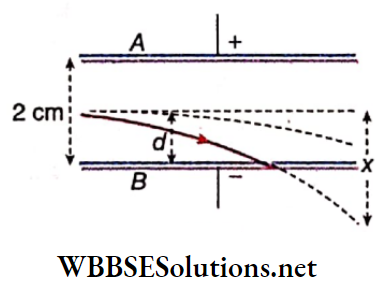
Uniform electric field in the intermediate space,
⇒ \(E=\frac{300 \mathrm{~V}}{2 \mathrm{~cm}}\)
= \(\frac{300 \mathrm{~V}}{0.02 \mathrm{~m}}\)
= \(15 \times 10^3 \mathrm{~V} \cdot \mathrm{m}^{-1}\)
Let the charge q = 1.6 X 10-19 be positive.
So, a downward force acts on it due to the electric field E given by
F = qE
∴ Downward acceleration, \(a:=\frac{q E}{m}\)
At the point of entry, let v be the velocity of the charged particle. In tire axial direction, it experiences no force; so the time taken to travel the distance l is t = \(\frac{1}{v}\).
Again, at the point of entry, the downward component of velocity = 0; Thus the downward displacement in time t is
⇒ \(x=\frac{1}{2} a t^2=\frac{1}{2} \frac{q E}{m}\left(\frac{l}{v}\right)^2\)
The condition, that the particle will not emerge from the space between the plates, is
⇒ \(x ≥ d\)
or, \(\frac{1}{2} \frac{q E}{m}\left(\frac{l}{v}\right)^2 ≥ d\)
or, \(\frac{1}{2} \frac{q E l^2}{m d} ≥ v^2 \)
or, \(v≤ l \sqrt{\frac{q E}{2 m d}}\)
Therefore, the maximum permitted velocity is
⇒ \(v_{\max }=l \sqrt{\frac{q E}{2 m d}}\)
= \(0.1 \times \sqrt{\frac{\left(1.6 \times 10^{-19}\right) \times\left(15 \times 10^3\right)}{2 \times\left(12 \times 10^{-24}\right) \times 0.01}}\)
= 104 m.s-1
Example 8. An infinite number of charges, each of value q, are placed on the x-axis at the points x = 1, x = 2, x = 4, x = 8,… Find the potential and intensity due to these charges at x = 0. If the charges are alternately positive and negative what will be the potential and intensity at the same point?
Solution:
If V is the potential at x = 0, then
⇒ \(V=\frac{q}{1}+\frac{q}{2}+\frac{q}{4}+\frac{q}{8}+\cdots \infty\)
⇒ \(q\left(1+\frac{1}{2}+\frac{1}{4}+\frac{1}{8}+\cdots \infty\right)=q\left(\frac{1}{1-\frac{1}{2}}\right)\)
= 2q
If E is the intensity at x = 0, then
⇒ \(E=\frac{q}{1^2}+\frac{q}{2^2}+\frac{q}{4^2}+\frac{q}{8^2}+\cdots \infty\)
⇒ \(q\left(1+\frac{1}{4}+\frac{1}{16}+\frac{1}{64}+\cdots \infty\right)\)
⇒ \(q\left(\frac{1}{1-\frac{1}{4}}\right)=\frac{4 q}{3}\) in the direction of negative x -axis
In the second case, when the consecutive charges are of opposite site signs, let us assume that the first charge is positive. Then potential,
⇒ \(V=\frac{q}{1}-\frac{q}{2}+\frac{q}{4}-\frac{q}{8}+\cdots \infty\)
⇒ \(q\left(1-\frac{1}{2}+\frac{1}{4}-\frac{1}{8}+\cdots \infty\right)=q\left(\frac{1}{1+\frac{1}{2}}\right)=\frac{2 q}{3}\)
Intensity, \(E=\frac{q}{1^2}-\frac{q}{2^2}+\frac{q}{4^2}-\frac{q}{8^2}+\cdots \infty\)
⇒ \(q\left(1-\frac{1}{4}+\frac{1}{16}-\frac{1}{64}+\cdots \infty\right)\)
⇒ \(q\left(\frac{1}{1+\frac{1}{4}}\right)=\frac{4 q}{5}\); in the direction of negative x-axis
Example 9. Two soap bubbles of equal volume are joined together to form a larger bubble. If each bubble had a potential V, find the potential of the resultant bubble.
Solution:
Let the radius of the smaller bubble be r and that of 47ce0r the larger bubble be R . Charge of each bubble- q.
According to the question,
⇒ \(\frac{4}{3} \pi R^3=2 \cdot \frac{4}{3} \pi r^3 \quad \text { or, } R=2^{1 / 3} \cdot r\)
The potential of each soap bubble,
⇒ \(V=\frac{q}{r} \quad \text { or, } q=V r\)
∴ The potential of the larger bubble
⇒ \(=\frac{\text { total charge }}{\text { radius }}=\frac{2 q}{R}=\frac{2 V r}{R}=\frac{2 V r}{2^{1 / 3} r}=.2^{\frac{2}{3}} V\)
Example 10. An electric dipole of moment 5 x 10-8 C In an electric field of magnitude 4 x 105 N.C-1. What amount of work is to be done to deflect it through an angle of 60°?
Solution:
We know, work done, AO = BO = CO = DO = 1 m
W = pE(1- cos0)
= 5 x 10-8 x 4 x 105(1- cos60°)
Here, p = 5 x 10-8C.m,
E = 4 x 105 N.C-1,
B = 60°
W = 2 x 10-2(1 -0.5)
= 10-2 J
Example 11. Find out the maximum charge on an unearthed hollow metal sphere of radius 3.0 m for which it would not discharge into the air. What would be the potential of the sphere in that condition? Assume that, electric discharge into air initiates at a field Intensity of 3 X 106 Vm-1.
Solution:
The electric field on the surface of a metal sphere of radius r has a charge q,
⇒ \(E=\frac{1}{4 \pi \epsilon_0} \frac{q}{r^2}\)
The maximum charge qm on the sphere, without any discharge into air, corresponds to E = 3 x 106 V.m-1.
∴ \(\frac{1}{4 \pi \epsilon_0} \frac{q_m}{r^2}=3 \times 10^6\)
or, \(\dot{q}_m=\frac{\left(3 \times 10^6\right) r^2}{1 /\left(4 \pi \epsilon_0\right)}\)
= \(\frac{3 \times 10^6 \times(3.0)^2}{9 \times 10^9}\)
= \(3 \times 10^{-3} \mathrm{C}\)
Under this condition, the potential of the sphere,
⇒ \(V=\frac{1}{4 \pi \epsilon_0 r} q=9 \times 10^9 \times \frac{3 \times 10^{-3}}{3.0}=9 \times 10^6 \mathrm{~V}\)
Example 12. Find the potential at the center of a square of side V2 m which carries at its four corners charges +2 x 10-9C, +1 x 10-9C, -2 x 10-9C, and +3 X 10-9C.
Solution:
AB = √2m = BC
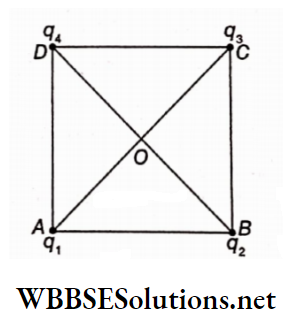
∴ \(A C=\sqrt{A B^2+B C^2}\)
= \(\sqrt{(\sqrt{2})^2+(\sqrt{2})^2}\)
=2m
= BD
∴ AO = BO = CO = DO = 1m
∴ \(V_O=\frac{1}{4 \pi \epsilon_0}\left(\frac{q_1}{A O}+\frac{q_2}{B O}+\frac{q_3}{C O}+\frac{q_4}{D O}\right)\)
⇒ \(9 \times 10^9 \times\left(\frac{2 \times 10^{-9}}{1}+\frac{1 \times 10^{-9}}{1}-\frac{2 \times 10^{-9}}{1}+\frac{3 \times 10^{-9}}{1}\right)\)
= 9 x (2 + 1 – 2 + 3)
= 36V
Example 13. Two charges q1 and q2 are placed 30 cm apart. A third charge q3 is moving along the arc of a circle of radius 40 cm from C to D. The change in the potential energy of the system is \(\frac{q_3}{4 \pi \epsilon_0} k\) What is the value of k?
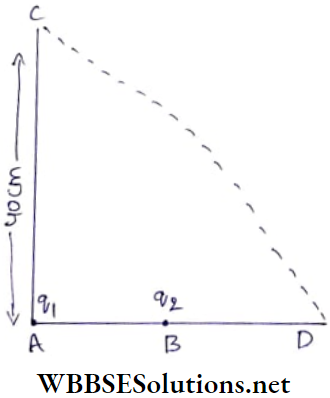
Solution:
The initial potential energy of the system,
⇒ \(U_i=\frac{1}{4 \pi \epsilon_0}\left(\frac{q_1 q_3}{0.4}+\frac{q_2 q_3}{0.5}+\frac{q_1 q_2}{0.3}\right)\) (∵ BC= 50 cm)
Similarly, the final potential energy of the system,
⇒ \(U_f=\frac{1}{4 \pi \epsilon_0}\left(\frac{q_1 q_3}{0.4}+\frac{q_2 q_3}{0.1}+\frac{q_1 q_2}{0.3}\right)\)
Then, change in potential energy,
⇒ \(\Delta U=U_f-U_i=\frac{1}{4 \pi \epsilon_0}\left(\frac{q_2 q_3}{0.1}-\frac{q_2 q_3}{0.5}\right)\)
Accordingly,
⇒ \(\frac{1}{4 \pi \epsilon_0}\left(\frac{q_2 q_3}{0.1}-\frac{q_2 q_3}{0.5}\right)=\frac{q_3}{4 \pi \epsilon_0} k\)
or, \(q_2\left(\frac{1}{0.1}-\frac{1}{0.5}\right)=k \quad\)
or, \(k=q_2(10-2)=8 q_2\)
k = 8q2
Example 14. Two charges, each of +103 esu, are placed at two points A and B separated by a distance of 200 cm. From the middle point of AB, along its perpendicular bisector, a particle having -103 esu of charge is thrown upwards with energy 104 erg. Determine the maximum height attained by the particle. The effect of gravitation can be neglected.
Solution:
Let us assume that the charged particle turns back from D.
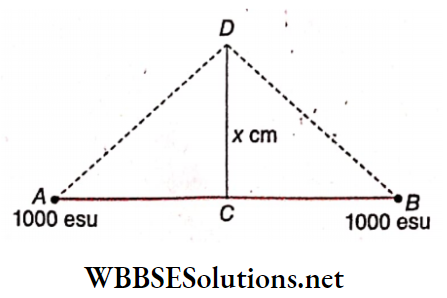
Let the distance between C and D be x cm. For moving the charged particle from C to D, we may write from the conservation of mechanical energy, initial kinetic energy = increase in electrical potential energy.
Potential at C due to charges placed at A and B,
⇒ \(V_C=\frac{1000}{A C}+\frac{1000}{B C}\)
But AC = BC = 100 cm
∴ \(V_C=\frac{1000}{100}+\frac{1000}{100}\)
= 20 esu
When -1000 esu of charge is at C then the potential energy of the system,
⇒ \(U_C=V_C \times(-1000)=-20 \times 10^3 \mathrm{erg}\)
Again, potential at D due to charges placed at A and B,
⇒ \(V_D=2 \times \frac{1000}{\sqrt{x^2+100^2}} \text { esu }\)
Thus, when -1000 esu of. charge is at D, the potential energy of the system,
⇒ \(U_D=V_D \times(-1000)=2 \times \frac{1000}{\sqrt{x^2+100^2}}(-1000) \mathrm{erg}\)
Accordingly,
UD-UC = initial kinetic energy of the particle at C
or, \(\left[20-\frac{2 \times 10^3}{\sqrt{x^2+10^4}}\right] \times 10^3=10^4\)
or, \(\frac{-2 \times 10^3}{\sqrt{x^2+10^4}}=10-20\)
or, \(\sqrt{x^2+10^4}=200\)
x = 173.2 cm
Therefore, the particle will turn back after covering a distance of 173.2 cm.
Example 15. Two point charges of values -20 esu and +20 esu are placed on the x-axis at x = -10 cm and x = +10cm respectively. Calculate
1. The potential and
2. The electric fields at the points P(0, 10) and Q(20, 0).
3. Find the work done in carrying a positive charge of value + 6 esu from P to Q along a straight line joining them,
4. Is there any path along which the work done is less than the above value? Why?
Solution:
1. Two charges + 20 esu and -20 esu are placed at A and B respectively.
Coordinates of P are (0. 10),
Thus, AP = BP = \(\sqrt{10^2+10^2}\)
= \(10 \sqrt{2} \mathrm{~cm}\)
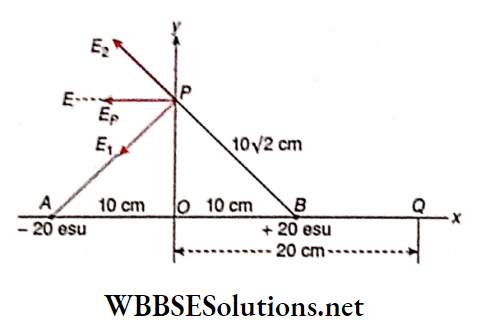
Potential at \(P, V_P=-\frac{20}{A P}+\frac{20}{B P}=0\)
The coordinates of Q are (20, 0).
So, AQ = 30 cm and BQ = 10 cm
Thus potential at Q,
⇒ \(V_Q=\frac{20}{B Q}-\frac{20}{A Q}\)
= \(\frac{20}{10}-\frac{20}{30}\)
= \(\frac{4}{3}\)
= 1.33 esu
2. Electric field intensity at P due to the charge -20 esu at A is
⇒ \(E_1=\frac{20}{A P^2} \text {; along } \overrightarrow{P A}\)
Again, electric field intensity at P due to the charge + 20 esu at B is
⇒ \(E_2=\frac{20}{B P^2} ; \text { along extended } \overrightarrow{B P}\)
Along the y-axis, a component of E1,
⇒ \(\left(E_1\right)_y=\frac{20}{A P^2} \sin \theta \text {; along } \overrightarrow{P O}\) [Here θ = ∠PAO = ∠PBO]
Along the y-axis, a component of E2,
Potential at the center of the loop A due to charge on it,
⇒ \(\left(E_2\right)_y=\frac{20}{B P^2} \sin \theta ; \text { along } \overrightarrow{P Y}\)
∴ AP = BP
⇒ \(\left(E_1\right)_y=-\left(E_2\right)_y\)
Hence along y -y-axis, the resultant of the component of E1 and E2 becomes zero.
Again along x -the axis, the component of E1 is
⇒ \(\left(E_1\right)_x=\frac{20}{A P^2} \cos \theta ; \text { along } \overrightarrow{P E}\)
⇒ \(\left(E_2\right)_x=\frac{20}{B P^2} \cos \theta ; \text { along } \overrightarrow{P E}\)
⇒ \(\left(E_1\right)_x \text { and }\left(E_2\right)_x\) are equal and acting in the same direction.
∴ Resultant of \(\left(E_1\right)_x \text { and }\left(E_2\right)_x\)
⇒ \(E_x=\frac{20}{A P^2} \cos \theta+\frac{20}{B P^2} \cos \theta=2 \times \frac{20}{A P^2} \cos \theta\)
Thus resultant of the y component of electric field Intensity is zero, so
⇒ \(E_P=E_x\)
= \(\frac{2 \times 20}{A P^2} \times \frac{O A}{A P}\)
= \(\frac{2 \times 20 \times 10}{\left(10^2+10^2\right)^{3 / 2}}\)
= 0.14 dyne/statcoulomb; along \(\vec{PE}\)
And Intensity at Q,
⇒ \(E_Q=\frac{20}{10^2}-\frac{20}{30^2}=\frac{20}{100}-\frac{20}{900}=\frac{8}{45}\)
= 0.178 = 0.18 dyne/statcoulomb; along \(\vec{QX}\)
2. Work done to bring a positive charge of value 6esu from P to Q,
⇒ \(W=6\left(V_Q-V_P\right)=6 \times \frac{4}{3}=8 \mathrm{erg}\)
3. As the electrostatic field is conservative, it does not depend on the path and the work done remains the same.
Example 16. Two circular loops of radii 0.05 m and 0.09 m are placed such that their axes coincide and their centres are 0.12m apart. A charge of 10-6C is spread uniformly on each loop. Find the potential difference between the centres of loops.
Solution:
Distance between the two centres, x = 0.12 m
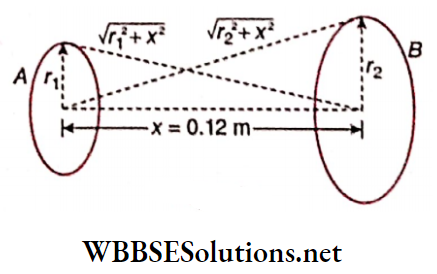
Potential at the center of the loop A due to charge on it,
⇒ \(V_A=\frac{1}{4 \pi \epsilon_0} \frac{q_1}{r_1}\)
= \(\frac{9 \times 10^9 \times 10^{-6}}{0.05}\)
⇒ \(=1.8 \times 10^5 \mathrm{~V}\)
Potential at the center of the loop A due to charge on loop B,
⇒ \(V_A^{\prime}=\frac{1}{4 \pi \epsilon_0} \frac{q_1}{\sqrt{r_2^2+x^2}}\)
= \(\frac{9 \times 10^9 \times 10^{-6}}{\sqrt{(0.09)^2+(0.12)^2}}\)
⇒ \(\frac{9 \times 10^3}{15 \times 10^{-2}}=0.6 \times 10^5 \mathrm{~V}\)
Therefore total potential at the centre of loop A,
⇒ \(\left(V_A\right)_T=V_A+V_A^{\prime}=(1.8+0.6) \times 10^5 \mathrm{~V}\)
=2.4 X 105 V
Now potential at the center of the loop H due to charge on it,
⇒ \(V_B=\frac{1}{4 \pi \epsilon_0} \frac{q_2}{r_2}=\frac{9 \times 10^9 \times 10^{-6}}{0.09}=1 \times 10^5 \mathrm{~V}\)
Potential at the center of the loop B due to charge on loop A,
⇒ \(V_B^{\prime}=\frac{1}{4 \pi \epsilon_0} \frac{q_2}{\sqrt{r_2^2+x^2}}\)
= \(\frac{9 \times 10^9 \times 10^{-6}}{\sqrt{(0.05)^2+(0.12)^2}}\)
⇒ \(\frac{9 \times 10^3}{13 \times 10^{-2}}=0.69 \times 10^5 \mathrm{~V}\)
Therefore total potential at the centre of loop B,
⇒ \(\left(V_B\right)_T=\left(V_B+V_B^{\prime}\right)=\left(1 \times 10^5+0.69 \times 10^5\right)\)
= 1.69 x 105 V
Thus potential differences,
⇒ \(\left(V_A\right)_T-\left(V_B\right)_T=(2.4-1.69) \times 10^5 \mathrm{~V}\)
= (2.4 – 1.69) X 105V
= 7.1 x 104 V ≈ 72kV
Example 17. Three-point charges 1C, 2C, and 3C are placed at the corners of an equilateral triangle of side 1 m. Calculate the work required to move these charges to the comers of a smaller equilateral triangle of side 0.5 m as shown.
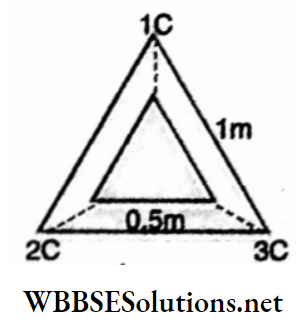
Solution:
The initial potential energy of the system i.e., for ΔABC = Ui = algebraic sum of potential energy of 3 pairs of charges.
So,\(U_i=\frac{1}{4 \pi \epsilon_0}\left(\frac{1 \times 2}{1}\right)+\frac{1}{4 \pi \epsilon_0}\left(\frac{1 \times 3}{1}\right)+\frac{1}{4 \pi \epsilon_0}\left(\frac{2 \times 3}{1}\right)\)
⇒ \(\frac{1}{4 \pi \epsilon_0}[2+3+6]=9 \times 10^9 \times 11\)
= 99 x 109J
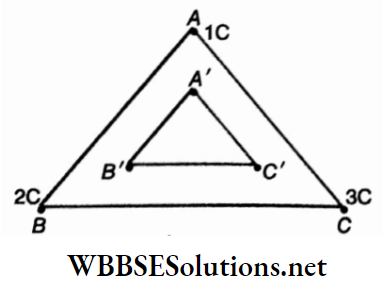
Again, the final potential energy of the system, Le., for ΔA’B’C’ = Uf = algebraic sum of the potential energy of 3 pairs of charges.
So, \(U_f=\frac{1}{4 \pi \epsilon_0}\left(\frac{1 \times 2}{0.5}\right)+\frac{1}{4 \pi \epsilon_0}\left(\frac{1 \times 3}{0.5}\right)+\frac{1}{4 \pi \epsilon_0}\left(\frac{2 \times 3}{0.5}\right)\)
⇒ \(\frac{1}{4 \pi \epsilon_0}[4+6+12]=9 \times 10^9 \times 22=198 \times 10^9 \mathrm{~J}\)
Hence, work required to move the charges,
W =Uf-Ui
= (198- 99) X 109 J
=9.9 x 1010 J
Example 18. A non-conducting disc of radius a with uniform positive surface charge density cr is placed on the ground with its axis vertical. A particle of mass m and positive charge q is dropped along the axis of the disc from a height H with zero initial velocity. Charge per unit of the particle is \(\frac{q}{m}=\frac{4 e_0 g}{\sigma}\).
- Find the value of H If the particle just reaches the disc,
- Find the height for its equilibrium position.
Solution:
Let us assume, the amount of charge in the ring of thickness dr is dq.
Potential at P due to this ring,
⇒ \(d V=\frac{1}{4 \pi \epsilon_0} \frac{d q}{x}, \text { where } x=\sqrt{H^2+r^2}\)
∴ \(d V=\frac{1}{4 \pi \epsilon_0} \frac{(2 \pi r d r) \sigma}{\sqrt{H^2+r^2}}\) ∵ dq = 2 πrdrσ
⇒ \(\frac{\sigma}{2 \epsilon_0} \frac{r d r}{\sqrt{H^2+r^2}}\)
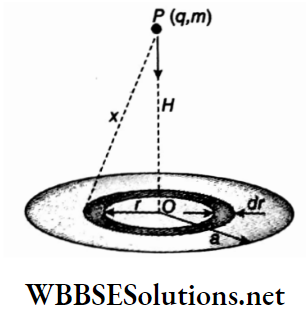
Now, the potential at P due to the complete disc,
⇒ \(V_P=\int_{r=0}^{r=a} d V=\frac{\sigma}{2 \epsilon_0} \int_{r=0}^{r=a} \frac{r d r}{\sqrt{H^2+r^2}}\)
⇒ \(V_P=\frac{\sigma}{2 \epsilon_0}\left[\sqrt{a^2+H^2}-H\right]\)
So potential at the centre (O) , \(V_o=\frac{\sigma a}{2 \epsilon_0}\)[∵ H = 0 ]
1. Particle is released from P and it just reaches O. Since initial kinetic energy = final kinetic energy = 0 Hence increase in kinetic energy = 0
From the conservation of mechanical energy, we may write, a decrease in gravitational potential energy = an increase in electrostatic potential energy.
mgH = q[VO – Vp]
or, \(m g H=(q)\left(\frac{\sigma}{2 \epsilon_0}\right)\left[a-\sqrt{a^2+H^2}+H\right]\)
or, \(g H=\left(\frac{q}{m}\right)\left(\frac{\sigma}{2 \epsilon_0}\right)\left[a-\sqrt{a^2+H^2}+H\right]\)…(1)
Given, \(\frac{q}{m}=\frac{4 \epsilon_0 g}{\sigma} \quad \text { or, } \frac{q \sigma}{2 \epsilon_0 m}=2 g\)
Substituting this value in equation (1), we get
⇒ \(g H=2 g\left[a+H-\sqrt{a^2+H^2}\right]\)
or, \(\frac{H}{2}=(a+H)-\sqrt{a^2+H^2}\)
or, \(a^2+H^2=a^2+\frac{H^2}{4}+a H \quad\)
or, \(\frac{3}{4} H^2=a H\)
H = \(\frac{4}{3}\)a [.. H not = 0]
2. Potential energy of the particle at height H = electrostatic potential energy + gravitational potential energy
or, U = qVp+ mgH [ Vp = electric potential at high H]
or, \(U=\frac{\sigma q}{2 \epsilon_0}\left[\sqrt{a^2+H^2}-H\right]+m g H\)…(2)
At equilibrium, \(F=-\frac{d U}{d H}=0\)
Differentiating equation, (2) with respect to H,
⇒ \(m g+\sigma \frac{q}{2 \epsilon_0}\left[\left(\frac{1}{2}\right)(2 H) \frac{1}{\sqrt{a^2+H^2}}-1\right]=0\)
or, \(m g+2 m g\left[\frac{H}{\sqrt{a^2+H^2}}-1\right]=0\)
or, \(1+\frac{2 H}{\sqrt{a^2+H^2}}-2=0 \quad\)
or, \(4 H^2-H^2=a^2\)
∴ \(H=\frac{a}{\sqrt{3}}\)
Example 19. Positive charges of magnitude 6nC, 12nC, and 24 nC are placed at the vertices A, B, and C of a square ABCD of side 20 cm. What is the amount of work done to place a charge of 1C at vertex D?
Solution:
The length of diagonal \(\sqrt{20^2+20^2}=20 \sqrt{2} \mathrm{~cm}\)
The electric potential at D,
⇒ \(V_D=\frac{1}{4 \pi \epsilon_0}\left[\frac{q_A}{A D}+\frac{q_C}{C D}+\frac{q_B}{B D}\right]\)
⇒ \(\frac{1}{4 \pi \epsilon_0}\left[\frac{6 \times 10^{-9}}{20 \times 10^{-2}}+\frac{24 \times 10^{-9}}{20 \times 10^{-2}}+\frac{12 \times 10^{-9}}{20 \sqrt{2} \times 10^{-2}}\right]\)
⇒ \(9 \times 10^9 \times \frac{10^{-9}}{10^{-2}}\left[\frac{6}{20}+\frac{24}{20}+\frac{12 \sqrt{2}}{40}\right]\)
⇒ \(900\left[\frac{12+48+12 \times 1.414}{40}\right]\)
= \(\frac{45}{2} \times 76.968\)
= 1731.78 V
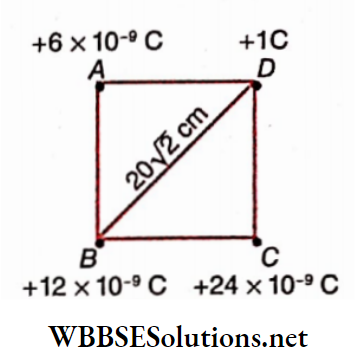
Hence the work done to place a charge of 1C at D = 1731.78J
Example 20. A proton is fired with a velocity of 7.45 X 105 m/s towards another free proton at rest. Calculate the minimum distance of approach between the protons. The mass of a proton = 1.66 X 10-22 kg
Solution:
Let us consider the moving proton to be the first proton and the free proton at rest to be the second proton.
The initial velocity of the first proton, v = 7.45 x 105 m/s. As the protons repel each other, the second proton starts moving away from the first proton.
The velocity of the first proton gradually decreases and that of the second proton gradually increases.
When the velocities of the two protons become equal, the distance between them will be minimal.
Let this velocity = v’
According to the law of conservation of momentum
mv + 0 = mv’ + mv’
or, v’ = \(\frac{v}{z}\)
Let the minimum distance of approach between the protons be r.
The electric potential energy of the protons when they are at a distance r apart = \(\frac{1}{4 \pi \epsilon_0} \cdot \frac{e}{r}\)
According to the law of conservation of energy,
⇒ \(\frac{1}{2} m v^2+0=\frac{1}{4 \pi \epsilon_0} \cdot \frac{e^2}{r}+\frac{1}{2} m v^{\prime 2}+\frac{1}{2} m v^{\prime 2}\)
⇒ \(\frac{1}{4 \pi \epsilon_0} \cdot \frac{e^2}{r}+m\left(\frac{\nu}{2}\right)^2\)
or, \(\frac{1}{4 \pi \epsilon_0} \cdot \frac{e^2}{r}=\frac{m v^2}{4}\)
or, \(r=\frac{4}{m v^2} \times \frac{e^2}{4 \pi \epsilon_0}=\frac{4 \times\left(1.6 \times 10^{-19}\right)^2 \times 9 \times 10^9}{1.66 \times 10^{-27} \times\left(7.45 \times 10^5\right)^2}\)
=1.0 x 10-12 m
Electrostatics
Electric Potential Equipotential Surface
Definition: A surface containing points at the same potential in an electric field is called an equipotential surface.
Equipotential surfaces due to an isolated point charge: Few equipotential surfaces due to an isolated positive point charge have been shown. We know that, for
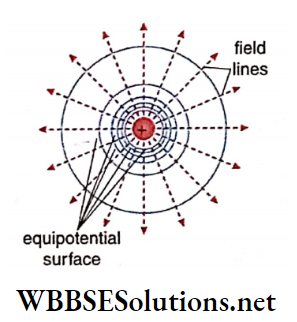
An isolated point charge q at a point O in a vacuum, potential at a distance r is \(\frac{1}{4 \pi \epsilon_0} \frac{q}{r}\) [in SI].
So if a hollow sphere of radius r is drawn taking O as the centre, the outer surface of the sphere will be an equipotential surface, because potential at all points on the surface is equal to \(\frac{1}{4 \pi \epsilon_0} \frac{q}{r}\).
The outer surfaces of all centric spheres so drawn will be equipotential surfaces. With O as a centre, the larger the radius of the sphere drawn, the smaller will be the surface potential.
Equipotential surfaces due to a uniform electric field:
A uniform electric field is represented by parallel and equispaced field lines. Equipotential surfaces in such a field would be normal to these field lines at every point in the field. Hence, each of these equipotential surfaces A, B, and C would be plane and parallel to each other. The surfaces correspond to different potentials V1, V2, V3 respectively; but the potential at every point on any particular surface is the same.
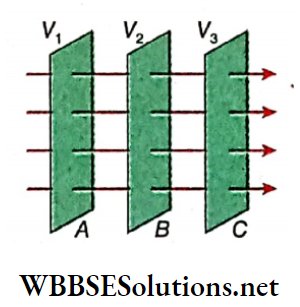
In a strong electric field, the potential changes quickly along the direction of the field lines; in a weaker field, this change is slower. As a result, the spacing between successive equipotential surfaces, for a given fixed potential difference, is less for a stronger field than that for a weaker field.
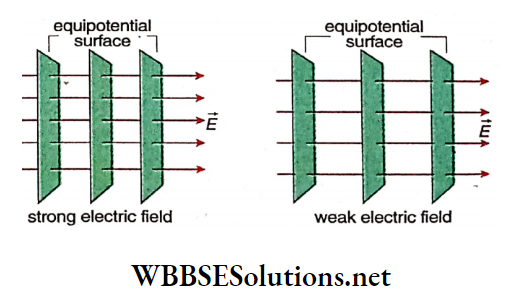
Equipotential surfaces for a pair of point charges: In this case, the shape of the equipotential surfaces depends on the algebraic sum, at any point in the electric field, of the potentials generated by the two-point charges separately. The equipotential surfaces O for two like charges of the same magnitude and θ for two unlike charges of the same magnitude, respectively. In the blue and red lines represent the equipotential surface and field lines, respectively.
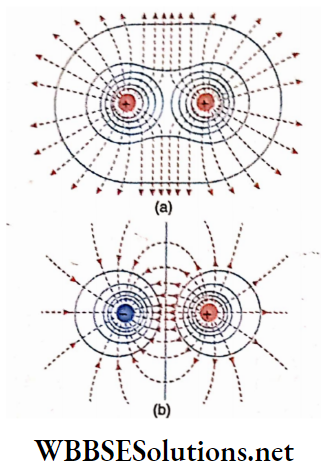
Properties of equipotential surfaces:
1. No work has to be done to move a charge from one point to another on an equipotential surface. Work done to move a unit positive charge from one point to another is equal to the potential difference between the two points.
Since the potential at all points on an equipotential surface is equal, to move a charge from one point to another on an equipotential surface, no work has tube done.
2. Field lines intersect the equipotential surface perpendicularly. Let us consider two points A and B very close to each other on an equipotential surface S.
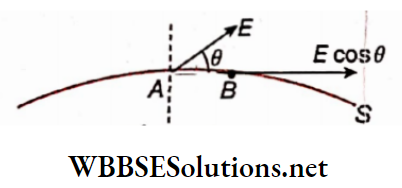
Let the electric field intensity E, in the region AB, make an angle 6 with the equipotential surface. Since A and B are very close to each other, AB may be taken as a straight line.
Component of electric intensity E along AB = Ecosθ. So work was done to move a unit positive charge from A to
B = Ecosθ x AB
From the property of an equipotential surface, we know that no work is done in moving a charge from one point to another on an equipotential surface.
∴ Ecosθ x AB = 0 or, cosθ = 0 [∵ AB ≠ 0; 13 ≠ 0]
or, \(\theta=\frac{\pi}{2}\)
So the direction of field Intensity Is perpendicular to the equipotential surface. We know that the direction of electric field intensity and that of a field line through any point is the same. So it may be said that the field lines intersect equipotential surfaces normally.
By calculus: Let us consider two points A and If very close to each other on surface S. VA and VB are the potentials at the points A and B respectively. So, the potential difference between A and B Is
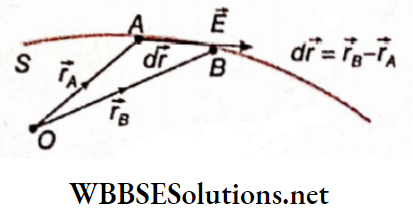
⇒ \(\Delta V=V_B-V_A=-\int_A^B \vec{E} \cdot d \vec{r}\)
By definition, on an equipotential surface, AV = 0 i.e., \(\vec{E} \cdot d \vec{r}=0\)
So, \(\vec{E}\) is normal to d\(\vec{r}\). The latter being tangential to the curve, E is normal to the surface represented by the curve.
3. If there is a difference of potential between two different points on the surface of a conductor, charges will begin to flow from one point to the other until the potential becomes the same at the two points. So top surface of a charged conductor is an equipotential surface and charges on such a surface, remain at rest.
4. No two equipotential surfaces intersect each other. Any intersection would mean that the point of intersection corresponds to two different potentials; also, there are two electric field intensities at that point in two normal directions. These are impractical.
The surface of a charged conductor is an equipotential surface—experimental demonstration:
We have already come to know that charge of a conductor resides on its surface. The surface charge density of a charged conductor depends on the shape of the conductor and is maximum at the region where its curvature is greatest.
But the potential at every point on the surface of a charged conductor is the same and is quite independent of the shape of the conductor.
To verify it experimentally, an insulated pear-shaped conductor A is charged positively, The disc of an uncharged gold leaf electroscope is connected by a wire to a proof-plane.
The electroscope is placed at such a large distance from the conductor that no electrical induction takes place in it. The proof-plane is held by its insulating handle and brought in contact with the pear-shaped conductor.
The proof-plane is moved to different parts of the surface and it is found that the divergence of leaves remain constant. This proves that the potential, on a charged conductor is uniform, i.e., the surface of a charged conductor is an equipotential surface.
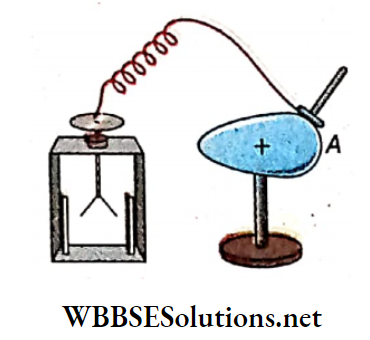
Electrostatics
Electric Potential Potential Inside A Hollow Conductor
Though no charge resides inside a hollow charged conductor, the potential at any point on the inner surface is equal to that at the outer surface of the conductor. This can be proved by the following experiment.
An insulated deep hollow metallic vessel C is charged positively and it is placed at a sufficient distance from a gold leaf electroscope. A proof-plane P is connected by a wire to the disc of the electroscope and is dipped gradually inside the vessel.
The leaves of the gold-leaf electroscope would diverge; this divergence would be maximum when the depth of the proof-plane becomes sufficiently larger than the dimensions of the top opening.
This divergence would not increase any more if the proof-plane is dipped farther, or is moved sideways. As the divergence of the leaves indicates the magnitude of potential, it can be said that the potential inside the vessel is constant.
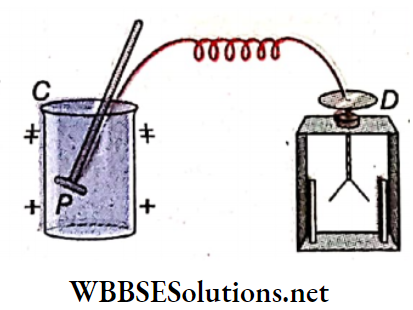
Now if the proof plane is made to touch the outer surface of the vessel, the magnitude divergence of the leaves does not change. This proves that the potential inside a charged hollow conductor is uniform, having the same value as that on its surface. The potential inside a charged hollow conductor, V = constant.
Hence, the electric field intensity,
⇒ \(E=-\frac{d V}{d x}=0\)
This means that the interior of a hollow conductor is associated with no electric field and no field line.
E = 0 in a region corresponds to V=constant; it does not necessarily mean that V = 0 in that region.
Electrostatics
Electric Potential Potential Inside A Hollow Conductor Numerical Examples
Example 1. Charge Q is distributed between two concentric hollow spheres placed in a vacuum in such a way that their surface densities of charge are equal. If the radii of the two spheres are r and R (R> r), calculate the potential at their centre.
Solution:
Let the charge on the smaller and the bigger spheres be Q1 and Q2, respectively
∴ Q = Q1 + Q2
As the surface densities of charge of the two spheres are equal,
∴ \(\frac{Q_1}{4 \pi r^2}=\frac{Q_2}{4 \pi \cdot R^2} \text { or, } \frac{Q_1}{Q_2}=\frac{r^2}{R^2}\)
or, \(\frac{Q_1+Q_2}{Q_2}=\frac{r^2+R^2}{R^2}\)
or, \(\frac{Q_2}{Q}=\frac{R^2}{r^2+R^2}\)
or, \(Q_2=\frac{Q \cdot R^2}{r^2+R^2}\)
Similarly, \(Q_1=\frac{Q \cdot r^2}{r^2+R^2}\)
Potential at the centre,
⇒ \(V=\frac{Q_1}{r}+\frac{Q_2}{R}\)
= \(\frac{Q \cdot r^2}{r\left(r^2+R^2\right)}+\frac{Q \cdot R^2}{R\left(r^2+R^2\right)}\)
= \(\frac{Q(r+R)}{r^2+R^2}\)
Example 2. Charges +2 x 10-7C, -4 x 10-7C and +8 x 10-7C are placed at the vertices of an equilateral triangle of side 10 cm in air. Determine the electrical potential energy of this system of charges.
Solution:
Distance between any two of the charges,
r = 10 cm = 0.1m.
The electrical potential energy’ of the system of charges is the algebraic sum of the potential energies of each pair of charges.
For air, permittivity is ∈0.
The potential energy of the system of charges
⇒ \(\frac{1}{4 \pi \epsilon_0}\left(\frac{q_1 q_2}{r}+\frac{q_2 q_3}{r}+\frac{q_3 q_1}{r}\right)\)
⇒ \(\frac{1}{4 \pi \epsilon_0 r}\left(q_1 q_2+q_2 q_3+q_3 q_1\right)\)
⇒ \(=\frac{1}{4 \pi \epsilon_0 \times 0.1}[2 \times(-4)+(-4) \times 8+8 \times 2] \times 10^{-7}\)
⇒ \(\frac{9 \times 10^9}{0.1} \times\left[-8 \times 10^{-14}-32 \times 10^{-14}+16 \times 10^{-14}\right]\)
⇒ \(-\frac{9 \times 24 \times 10^9 \times 10^{-14}}{0.1}\)
= -0.0216J
The negative sign indicates that 0.0216J work is to be done to transfer the charges from their positions to infinity.
Example 3. In a vacuum, three small spheres are placed on the circumference of a circle of radius r in such a way that an equilateral triangle is formed. If q is the charge on each sphere, determine the intensity of the electric field and potential at the centre of the circle.
Answer:
Let O be the centre of the circle. Three spheres are placed at the points A, B and C on the circumference of the circle. ABC is an equilateral triangle.
Intensity at O due to the charge at A,
⇒ \(E_A=\frac{q}{4 \pi \epsilon_0 r^2} \text {; along } \overrightarrow{A O}\)
Intensity at O due to the charge at B,
⇒ \(E_B=\frac{q}{4 \pi \epsilon_0 r^2} ; \text { along } \overrightarrow{B O}\)
Intensity at O due to the charge at C,
⇒ \(E_C=\frac{q}{4 \pi \epsilon_0 r^2} \text {; along } \overrightarrow{C O}\)
Resolving the above intensities along AO and perpendicular to AO we have,
intensity along AO = EA – EBcos60°-ECcos60º
⇒ \(\frac{1}{4 \pi \epsilon_0}\left[\frac{q}{r^2}-\frac{q}{r^2} \times \frac{1}{2}-\frac{q}{r^2} \times \frac{1}{2}\right]\)
= 0
intensity perpendicular to AO = EAcos90° + EBsin60°- ECsin60°
⇒ \(\frac{1}{4 \pi \epsilon_0}\left[0+\frac{q}{r^2} \sin 60^{\circ}-\frac{q}{r^2} \sin 60^{\circ}\right]\)
= 0
∴ Resultant intensity at O = 0 and electric potential at \(\frac{1}{4 \pi \epsilon_0}\left[\frac{q}{r}+\frac{q}{r}+\frac{q}{r}\right]=\frac{3 q}{4 \pi \epsilon_0 r}\) units
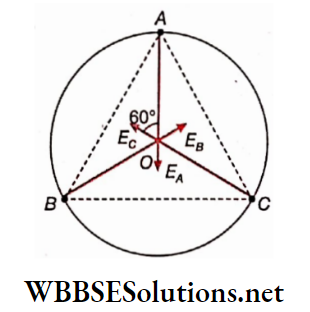
Example 4. A charged particle q Is thrown with a velocity v towards another charged particle Q at rest. It approaches Q up to the closest distance r and then returns. If q is thrown with a velocity of 2v, what should be the closest distance of approach?
Solution:
Let the closest distance of approach be r’.
From the principle of conservation of energy we have, kinetic energy = electrostatic potential energy.
In the first case,
⇒ \(\frac{1}{2} m v^2=\frac{1}{4 \pi \epsilon_0} \cdot \frac{q Q}{r}\)…(1)
In the second case,
⇒ \(\frac{1}{2} m(2 v)^2=\frac{1}{4 \pi \epsilon_0} \cdot \frac{q Q}{r^{\prime}}\)…(2)
Dividing equation (1) by equation (2) we get,
⇒ \(\frac{1}{4}=\frac{r^{\prime}}{r} \quad \text { or, } r^{\prime}=\frac{r}{4}\)
Example 5. In a vacuum, four charges each equal to q are placed at each of the four vertices of a square. Find the intensity and potential of the electric field at the point of intersection of the two diagonals.
Solution:
Let the length of each side of the square be a.
⇒ \(A C=\sqrt{A B^2+B C^2}=\sqrt{a^2+a^2}\)
= V2a
Now, AC = BD
and AO = BO = CO = DO = \(\frac{1}{2}\) AC
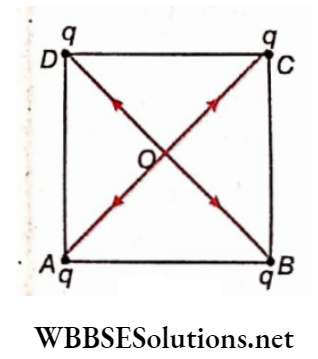
Therefore, intensity at O due to the charge q at A is given by
⇒ \(\frac{1}{2} \cdot \sqrt{2} a\)
= \(\frac{a}{\sqrt{2}}\)
Intensity at O due to the charge at C is given by
⇒ \(E_1=\frac{1}{4 \pi \epsilon_0} \cdot \frac{q}{\left(\frac{a}{\sqrt{2}}\right)^2} ; \text { along } \overrightarrow{O C}\)
These two intensities being equal and opposite balance each other.
Similarly, intensities at 0 due to the charges at B and D being equal and opposite balance each other. So the intensity at the point of intersection of the two diagonals is zero.
Potential at \(O=\frac{1}{4 \pi \epsilon_0} \cdot\left[\frac{q}{\frac{a}{\sqrt{2}}}+\frac{q}{\frac{a}{\sqrt{2}}}+\frac{q}{\frac{a}{\sqrt{2}}}+\frac{q}{\frac{a}{\sqrt{2}}}\right]\)
= \(\frac{4 \sqrt{2} q}{4 \pi \epsilon_0 a}\)
Example 6. Three-point charges q, 2q and 8q are to be placed–on a 0.09 m long straight line. Find the positions of the charges so that the potential energy of this system becomes minimal. In this situation, find the Intensity at the position of the charge q due to the other two charges.
Solution:
Let the charge 2q be placed in between the charges q and 8q and the distance between q and 2q be x metre.
So, the distance between 2q and 8q = (0.09 JC) m

The potential energy of the system,
⇒ \(U=\frac{1}{4 \pi \epsilon_0}\left[\frac{q \cdot 2 q}{x}+\frac{2 q \cdot 8 q}{(0.09-x)}+\frac{q \cdot 8 q}{0.09}\right]\)
⇒ \(9 \times 10^9 \times 2 q^2\left[\frac{1}{x}+\frac{8}{(0.09-x)}+\frac{4}{0.09}\right]\)
For minimum value of U, \(\frac{dU}{dx}\) = 0
i,e., \(9 \times 10^9 \times 2 q^2\left[-\frac{1}{x^2}+\frac{8}{(0.09-x)^2}\right]\)
= 0
or, \(\frac{1}{x}=\frac{2 \sqrt{2}}{0.09-x}=\frac{2.83}{0.09-x}\)
or, x = 0.0235
So, the charge 2q is to be placed at a distance of 0.0235 m, i.e., 2.35 cm from the charge q.
Electric field intensity at the position of the charge q due to the
other charges,
⇒ \(E=9 \times 10^9 \times \frac{2 q}{x^2}+9 \times 10^9 \times \frac{8 q}{(0.09)^2}\)
⇒ \(9 \times 10^9 \times 2 q\left[\frac{1}{(0.0235)^2}+\frac{4}{(0.09)^2}\right]\)
4.148 X 1013q N.C-1
Electrostatics – Electric Potential Conclusion
- The potential at any point In an electric field is defined as the amount of work done in bringing a unit positive charge from infinity to that point.
- The potential of a positively charged body is called positive potential and that of a negatively charged body is called negative potential.
- In a static electric field,
- The total work done in carrying a charge taken around a closed path is zero
- The potential difference between two points does not depend on the path followed by any charge between the two points.
Unit of electric potential:
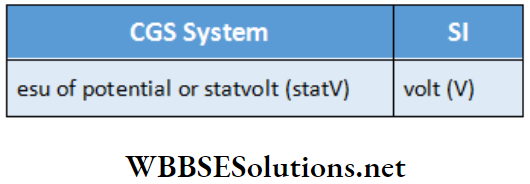
- 1 esu of potential = 300 V.m-1 The potential of the earth Is taken us zero. The potential of other bodies Is expressed with reference to this zero potential of the earth.
- The potential of any charged body connected to the earth becomes zero.
- The electrostatic potential energy of a system of charges is defined as the work done to bring the charges from infinity to their positions to constitute the system.
- An electronvolt (eV) is a unit of work, defined as the work done when an electron crosses a potential difference of 1 V. leV = 1.6 x 10-19J
- An equipotential surface is a surface containing the points having the same potential in an electric field
Potential at a point at distance x from a point charge q placed in air or in a vacuum:
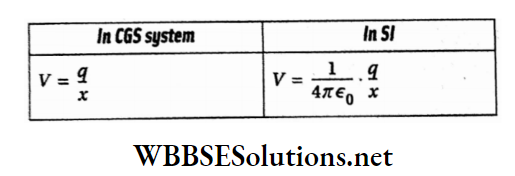
Potential due to a system of charges:
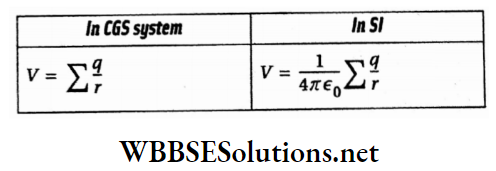
In a uniform electric field, VA and VB are the electric potentials at the points A and B respectively. The separation between these points is d. If VA > VB, the relation between intensity and the potential difference between these two points is,
⇒ \(E=-\frac{V_A-V_B}{d}\)
For a non-uniform electric field, the intensity (E) and potential (V) are related as E = –\(\frac{dV}{dx}\)
Potential at any internal point of a uniformly charged sphere of radius r is the same and equal to the potential on the surface of the sphere,
i.e, \(V=\frac{1}{4 \pi \epsilon_0} \cdot \frac{q}{r}(\text { in } \mathrm{SI})\)
V = \(\frac{q}{r}\)
The electrical potential energy of a system of charges ql and q2 separated by a distance r is given by,
⇒ \(U=\frac{q_1 q_2}{4 \pi \epsilon_0 r} \quad \text { (in SI) }\)
⇒ \(U=\frac{q_1 q_2}{r} \text { (in CGS system) }\)
Work done in deflecting a dipole through an angle 6 from its equilibrium position in a uniform electric field.
In CGS system In SI (in SI)
W = pE(1- cosθ)
The potential energy of the dipole in this position,
V = pE(1- cosθ) [p = dipole moment of the electric dipole]
When a particle of mass m and charge q moves from rest in an electric field between two points due to a potential difference y existing between them, the velocity acquired by the particle is,
⇒ \(v=\sqrt{\frac{2 q V}{m}}\)
Electrostatics
Electric Potential Very ShortAnswer Type Questions
Question 1. What is the relation between statvolt and volt?
Answer: 1V = \(\frac{1}{300}\) statV
Question 2. A free electron moves from a higher to a lower potential. Is the statement correct?
Answer: No
Question 3. Write down the name of the physical quantity whose unit is J C-1
Answer: Potential
Question 4. What is the electric field intensity inside a charged conductor
Answer: 0
Question 5. what are the shapes of the equipotential surfaces in the field of a point charge?
Answer: Spherical surfaces with different radii
Question 6. What will be the shape of the equipotential surface siturated at infinity due to a point charge?
Answer: Plane
Question 7. Which physical quantity has the unit eV?
Answer: Electric energy
Question 8. Is the electric field conservative or non-conservative?
Answer: Conservative
Question 9. If a charge q moves through a potential difference V, what will be the kinetic energy of the charge?
Answer: Vp
Question 10. A positive charge +Q is placed at a point. A circle of radius r is drawn with the point as the centre. Another charge q is carried once in that circular path. What will be the work done?
Answer: Zero
Question 11. To transfer a charge of 20 C through a distance of 2 cm, 2 J work is performed. What is the potential difference between the endpoints of that distance?
Answer: 0.1V
Question 12. If the potential is constant around a point, what will be the electric field intensity at that point?
Answer: Zero
Electrostatics
Electric Potential Fill In The Blanks
1. l esu of potential = 300 V.
2. The electric field lines pass through an equipotential surface Perpendicularly
3. The surface of a charged conductor is an equipotential surface
4. The electrical potential energy of a unit charge placed at a point in an electrical field is the electric potential at that point.
5. In an electric field, if a charged body loses its potential energy, it gains an equal amount of kinetic energy
Electrostatics
Electric Potential Assertion-reason type
Direction: These questions have statement 1 and statement 2. Of the four choices given below, choose the one that best describes the two statements.
- Statement 1 is true, statement 2 is true, and statement 2 is a correct explanation for statement 1.
- Statement 1 is true, and statement 2 is true; statement 2 is not a correct explanation for statement 1.
- Statement 1 is true, and statement 2 is false.
- Statement 1 is false, and statement 1 is true.
Question 1.
Statement 1: For practical purposes, the potential of the earth is used as a reference, and is assumed to be the zero of potential in electrical circuits.
Statement 2: The electrical potential of a sphere of radius R, with charge Q uniformly distributed on its surface, is given by,
⇒ \(\frac{Q}{4 \pi \epsilon_0 R}\)
Answer: 1. Statement 1 is hue, statement 2 is true; statement n is a correct explanation for statement 1.
Question 2.
Statement 1: A non-zero electric potential may exist at a point where electric field strength is zero.
Statement 2: Both electric potential and electric field strength depend on the source charge and not on the test charge
Answer: 2. Statement 1 is true, statement 2 is true; statement 2 is not a correct explanation for statement 1.
Question 3.
Statement 1: If two source charges produce potentials Vj and V2 at a point, then the total potential at that point is
V1 + V2
Statement 2: Electric potential is a scalar quantity
Answer: 1. Statement 1 is hue, statement 2 is true; statement 2 is a correct explanation for statement 1.
Question 4.
Statement 1: A and B are two conducting spheres of the same radius, A being solid and B; being hollow. Both are charged to the same potential. Then, charge on A = charge on B.
Statement 2: Potentials on both are the same.
Answer: 1. Statement 1 is hue, statement 2 is true; statement 2 is a correct explanation for statement 1.
Question 5.
Statement 1: For a charged particle moving from point P to point Q , the net work done by an electrostatic field on the particle is independent of the path connecting points P and Q.
Statement 2: The net work done by a conservative force on an object moving along a closed loop is zero.
Answer: 1. Statement 1 is hue, statement 2 is true; statement 2 is a correct explanation for statement 1.
Question 6.
Statement 1: Due to an infinitely long linear charge distribution, the potential at any point at a distance r from the line is proportional to the log.
Statement 2: \(E \propto \frac{1}{r} \text { and } E=-\frac{d V}{d r}\)
Answer: 1. Statement 1 is hue, statement 2 is true; statement 2 is a correct explanation for statement 1.
Question 7.
Statement 1: Though electric potential is scalar, electric potential gradient is a vector quantity.
Statement 2: Potential gradient is the rate of change of potential with distance.
Answer: 2. Statement 1 is true, statement 2 is true; statement 2 is not a correct explanation for statement 1.
Question 8.
Statement 1: A system of three positive charges, each having a charge q and placed at equal distances from each other along a straight line cannot be in equilibrium.
Statement 2: The charge in the middle experiences zero net force, but the force acting on the charges at the extreme ends is not zero.
Answer: 1. Statement 1 is hue, statement 2 is true; statement 2 is a correct explanation for statement 1.
Electrostatics
Electric Potential Match The Columns
Question 1. The shape of equipotential surfaces and their charge distribution are given in column I and column n, respectively.
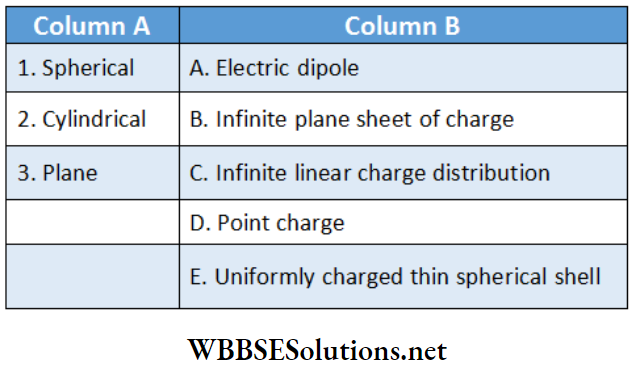
Answer: 1-D,E, 2-C, 3-A,B
Question 2. Match the nature of point charges in column I with the variation of their potentials in column n.
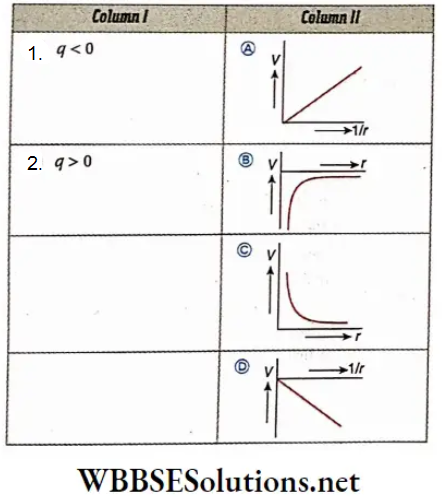
Answer: 1-B,D 2-A,C
Question 3. Potentialÿ at different points duo to the charged conductors of different shapes are given in the columns. Suppose, each of the given charged conductors has a radius r and x is the distance of a certain point from their centers.
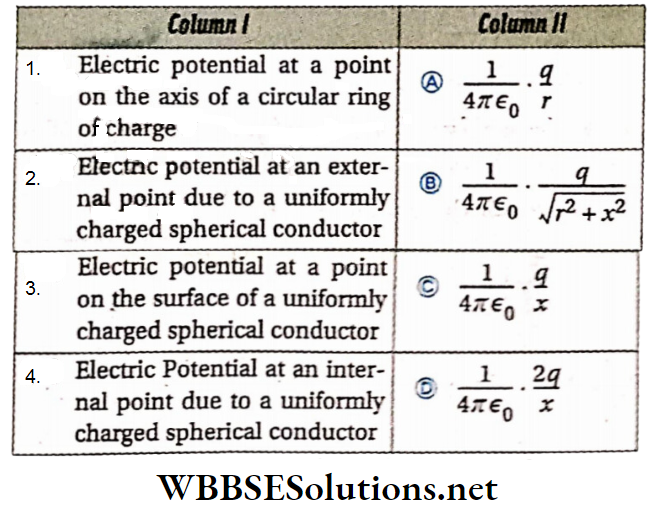
Answer: 1-B, 2-C, 3-A, 4-A
Question 4. Two spherical shells. Suppose r is the distance of a point from their common centre, then
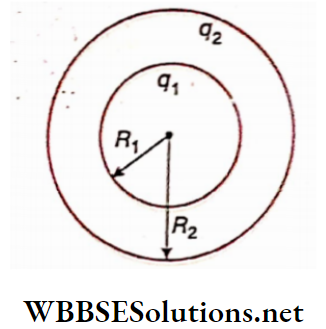
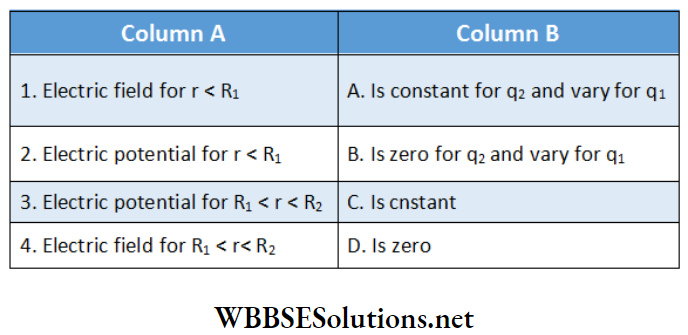
Answer: 1-D, 2-C, 3-A, 4-B

